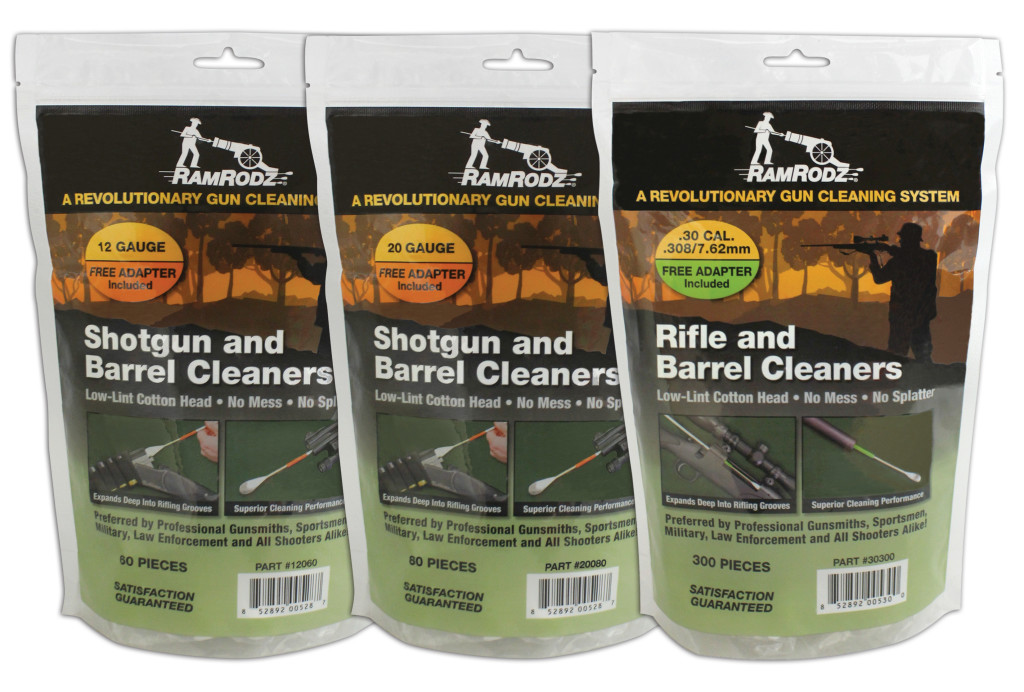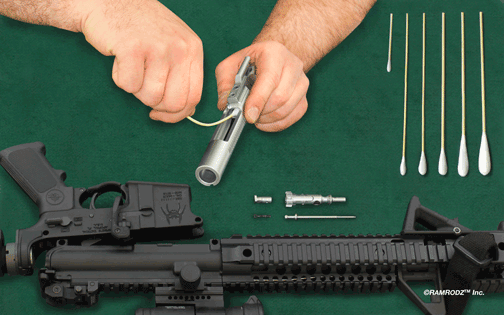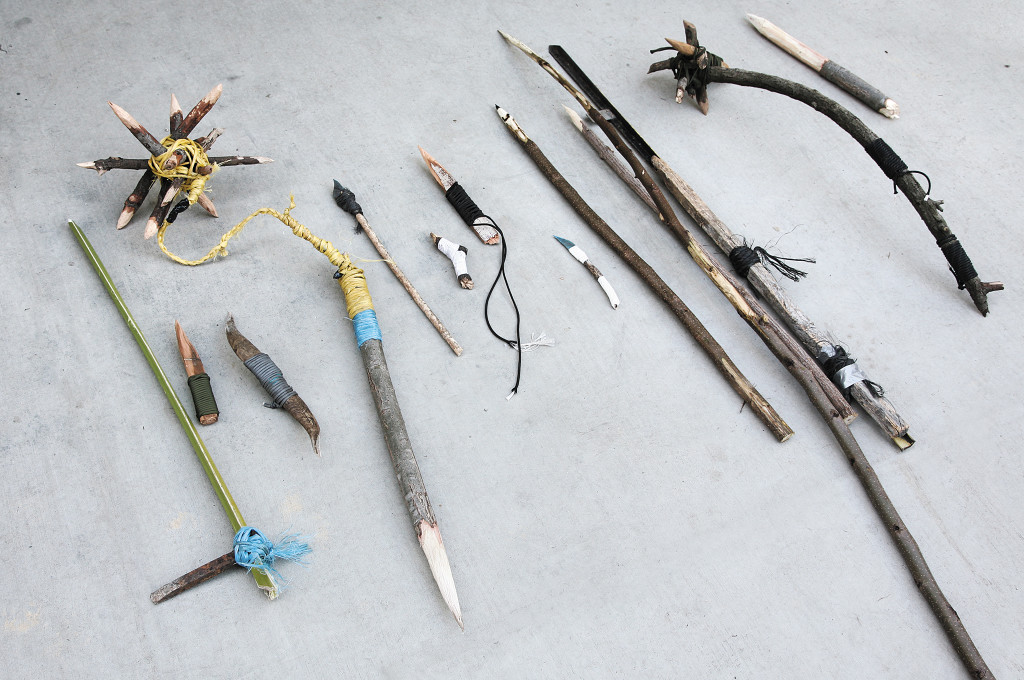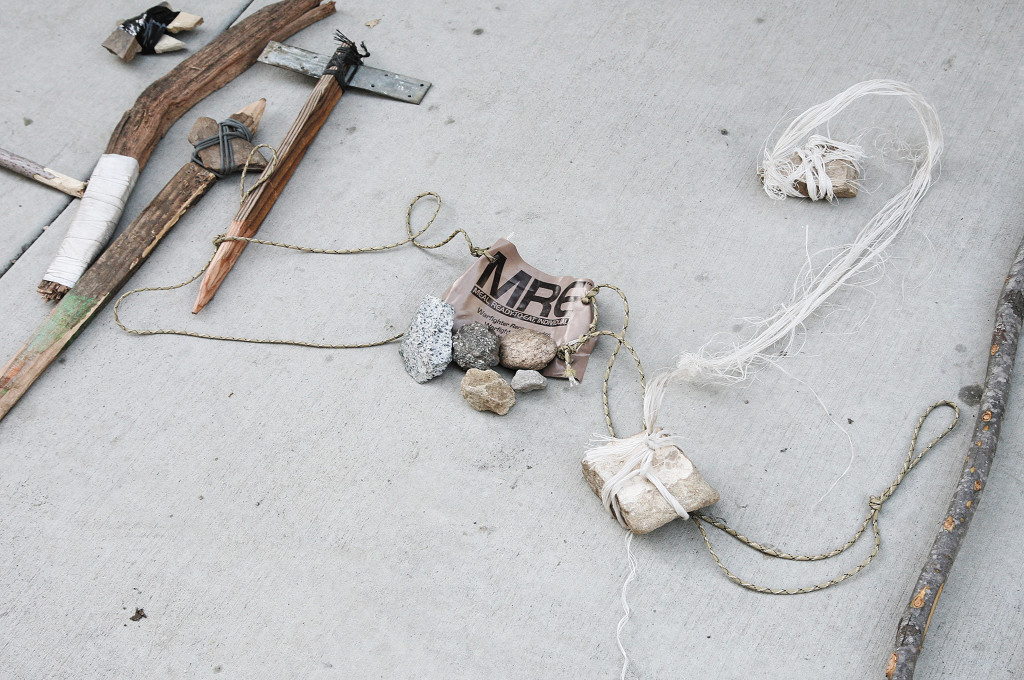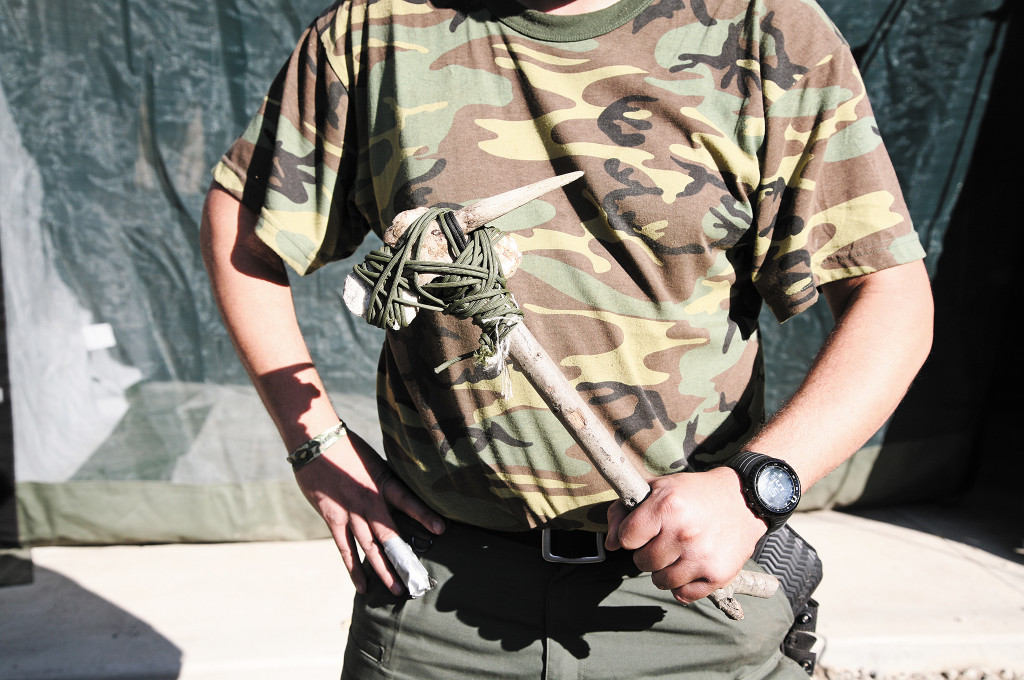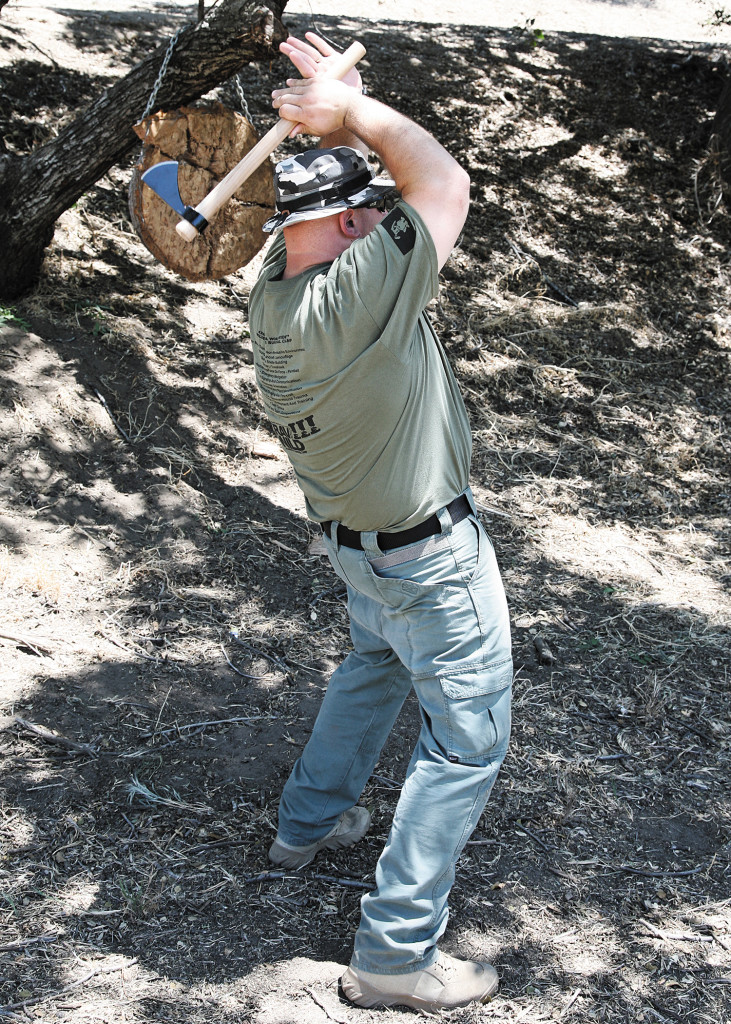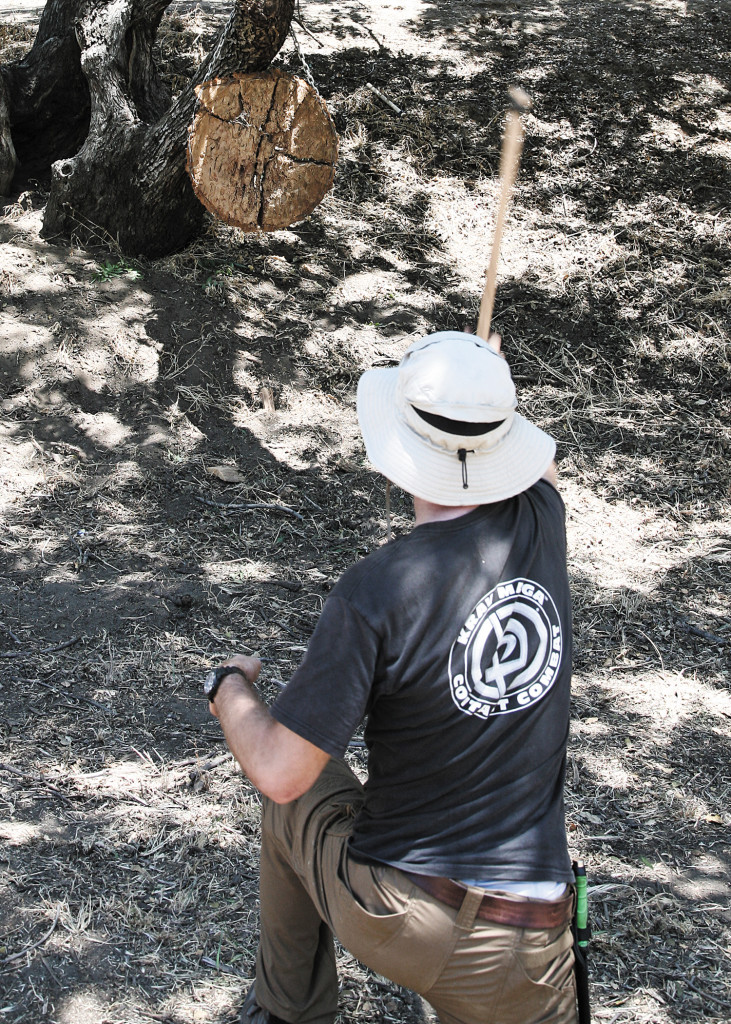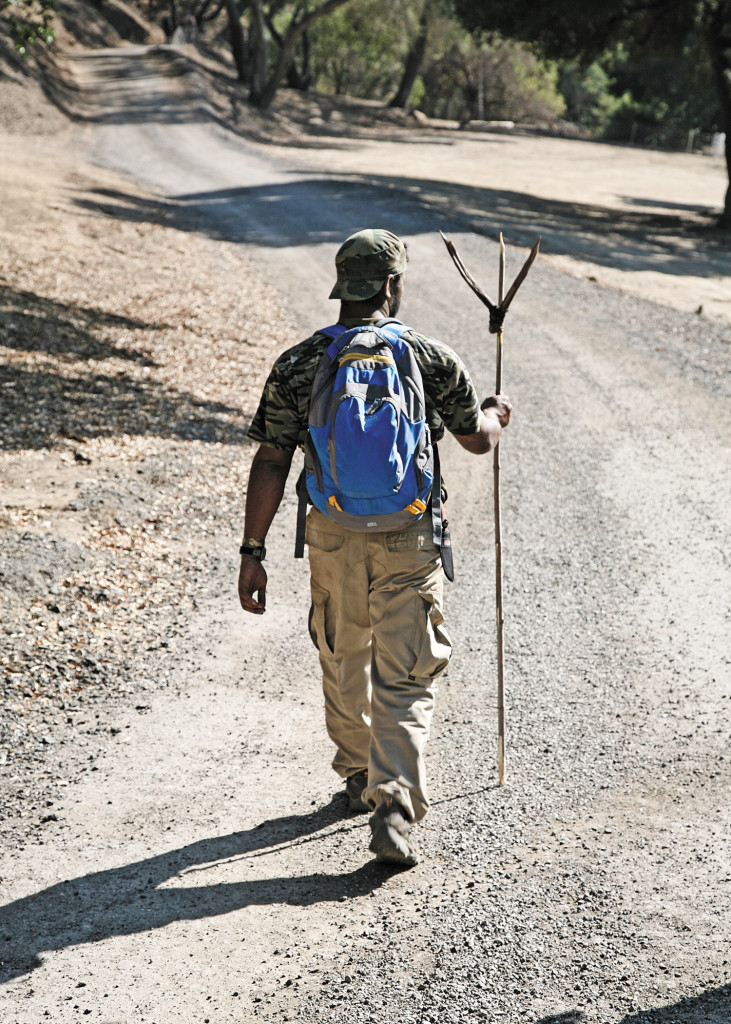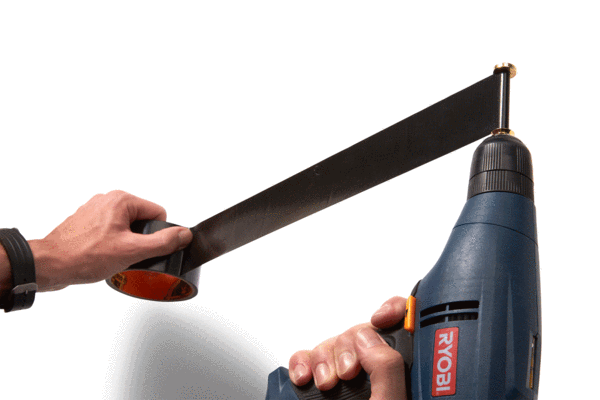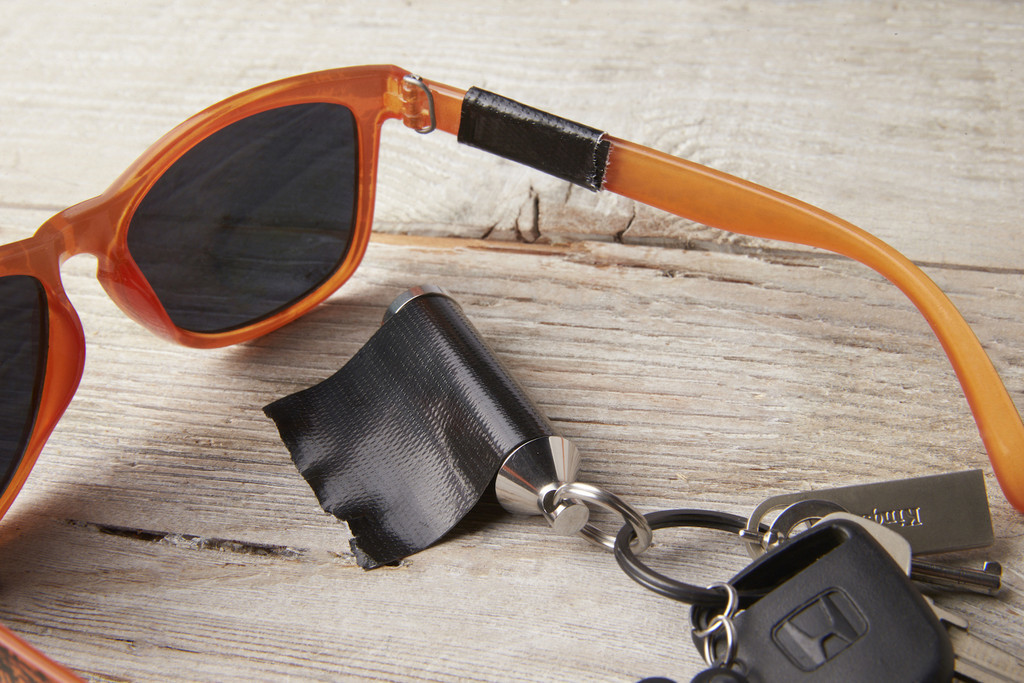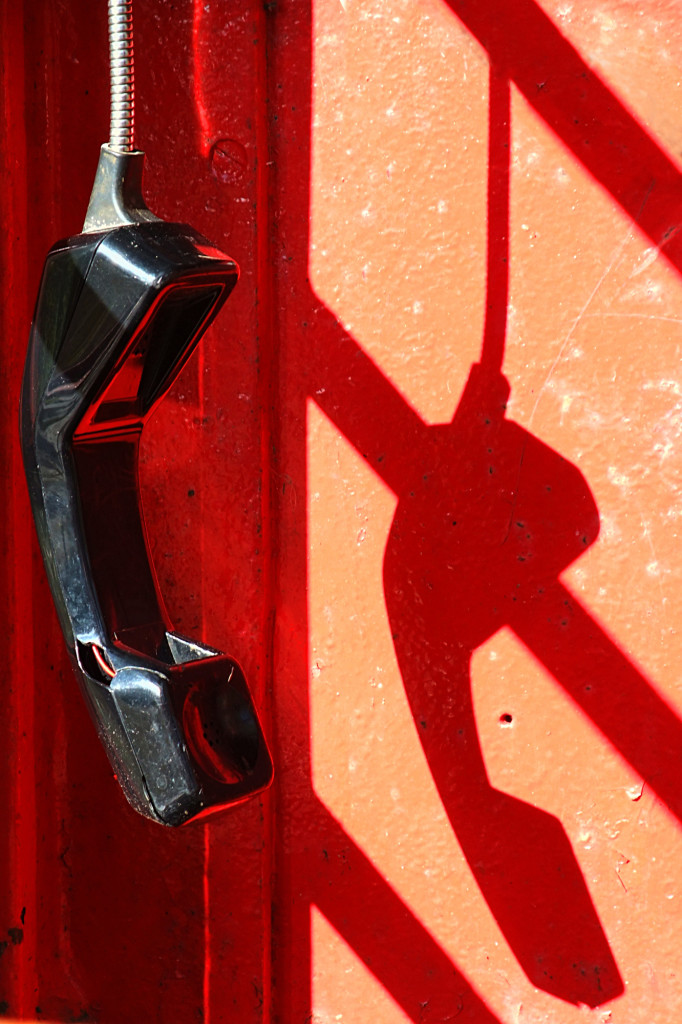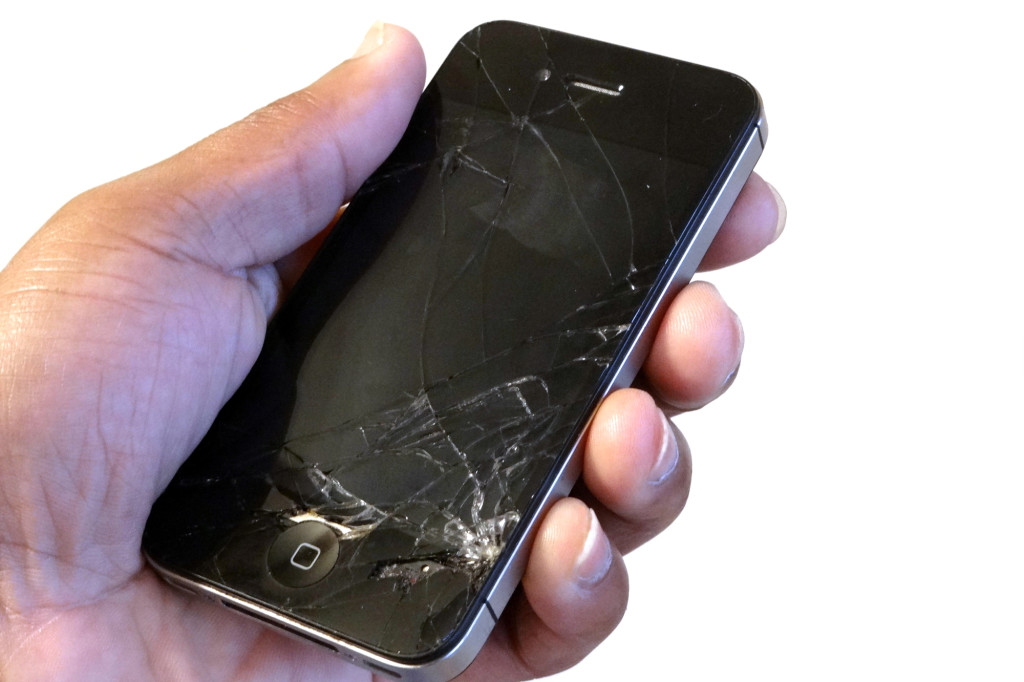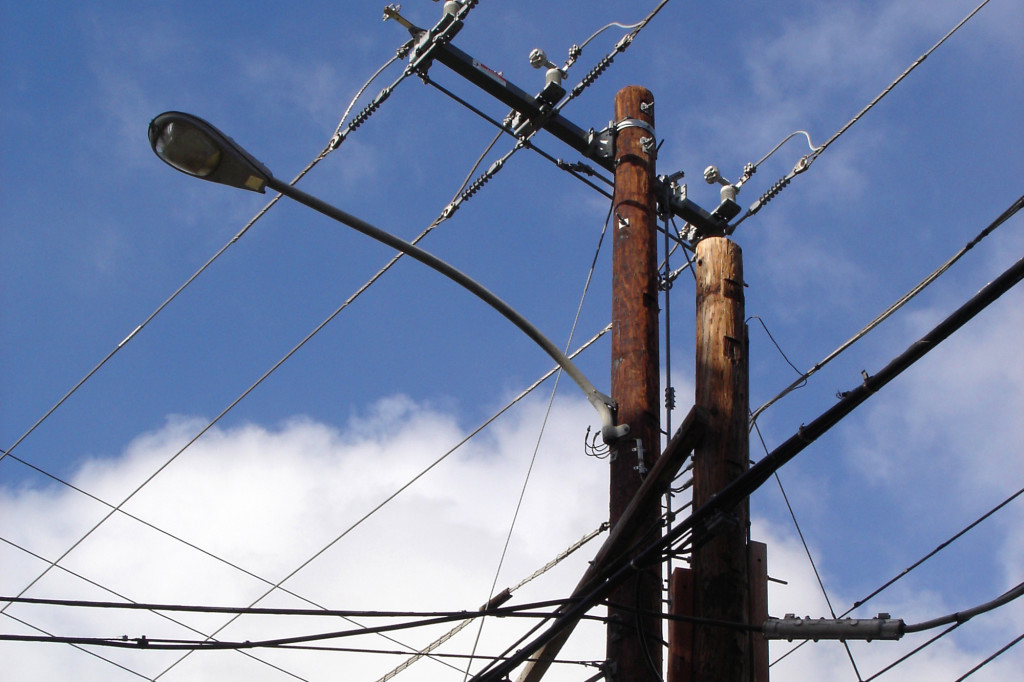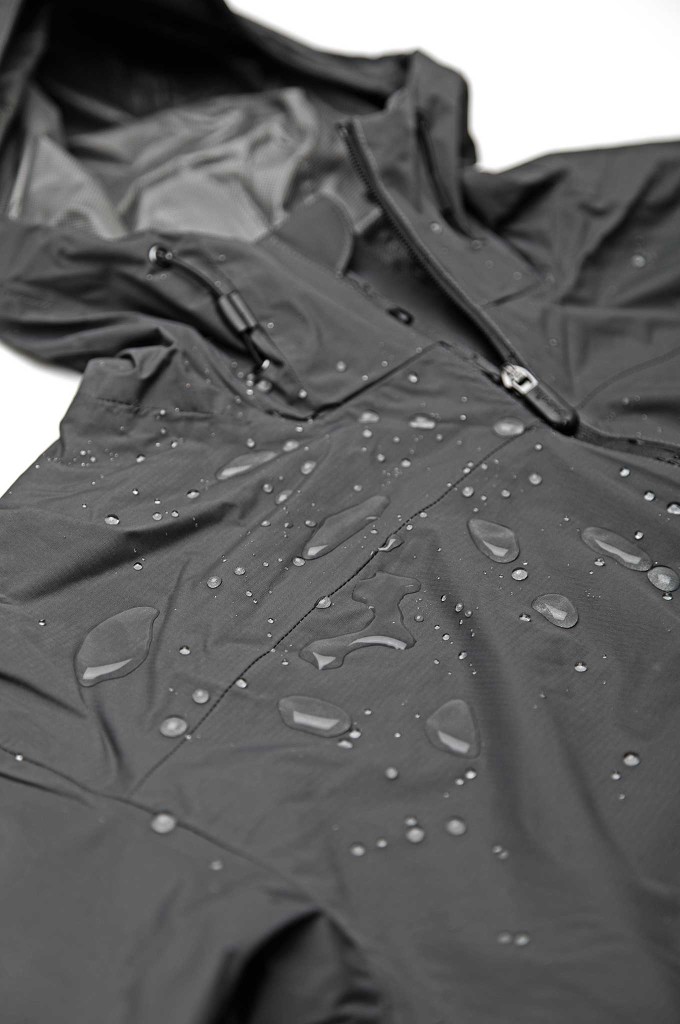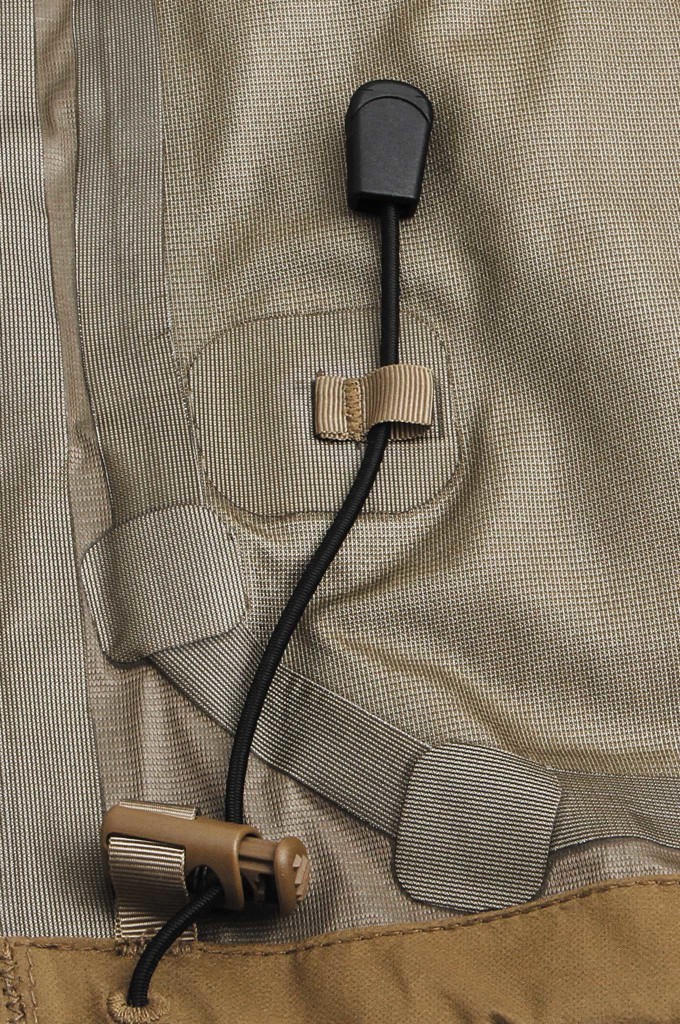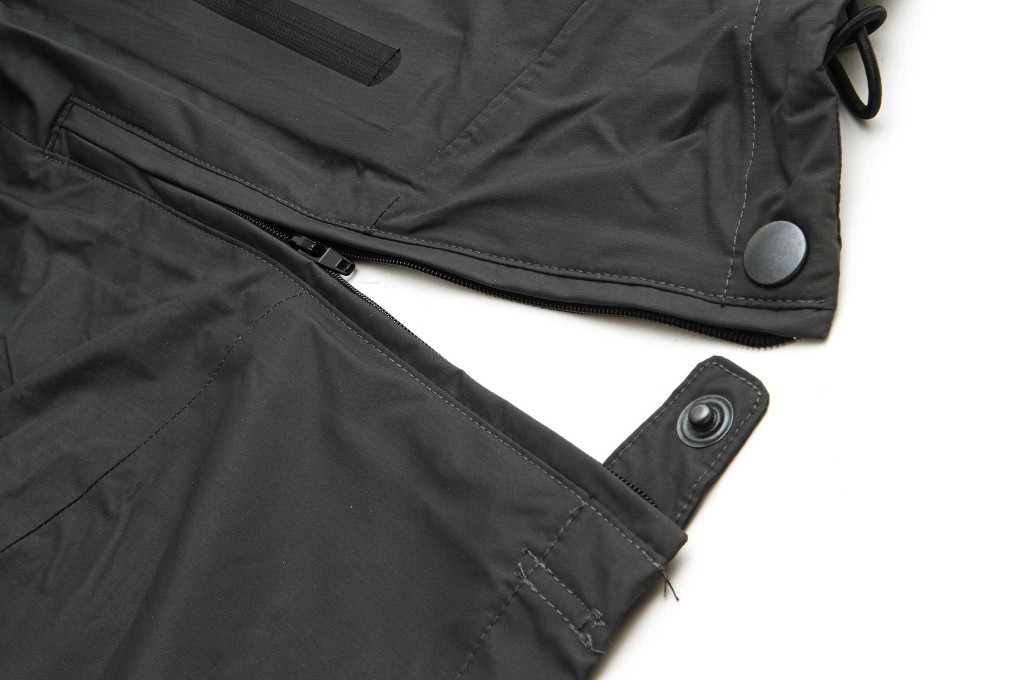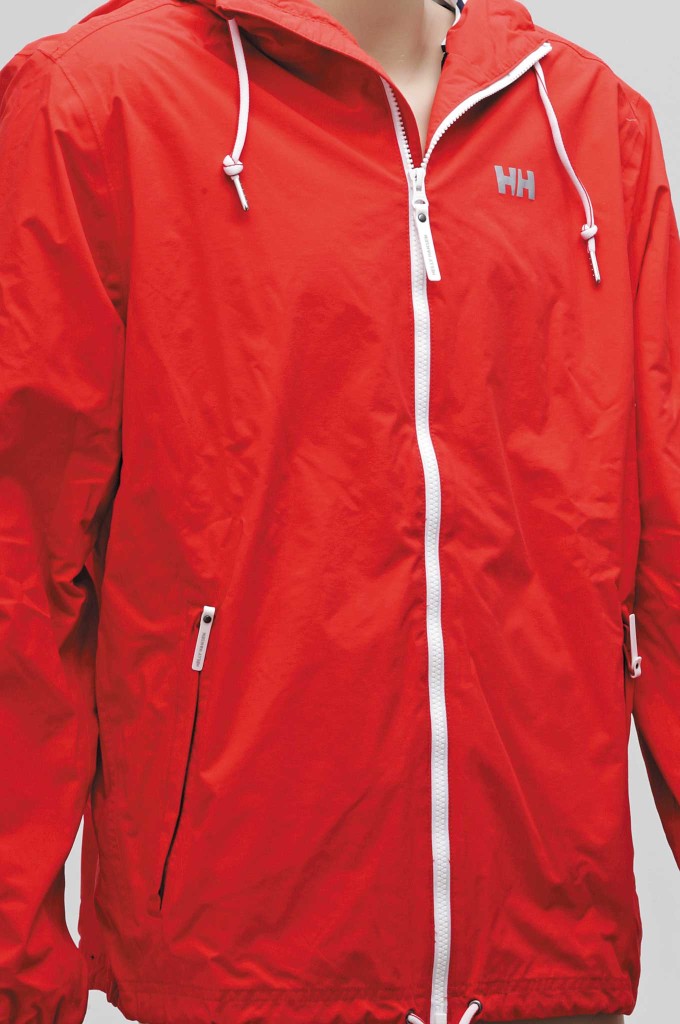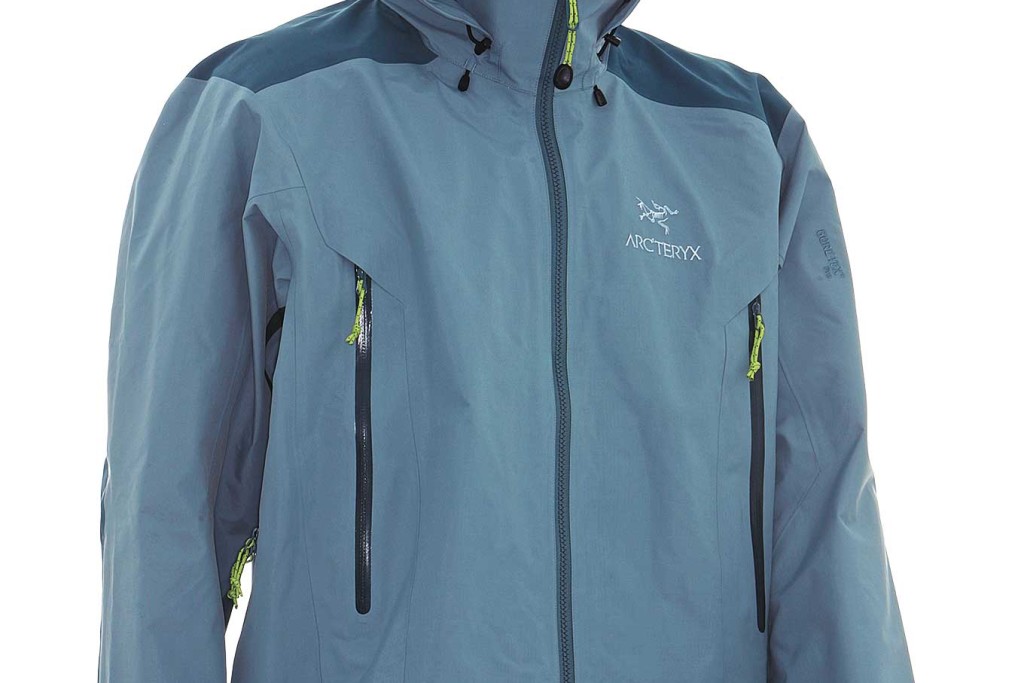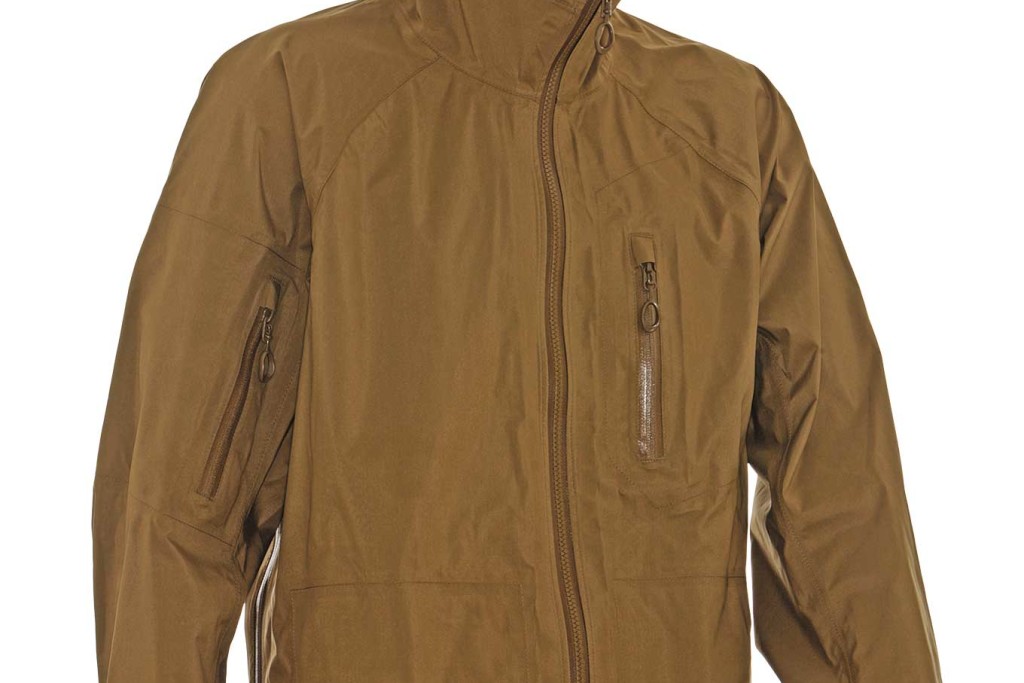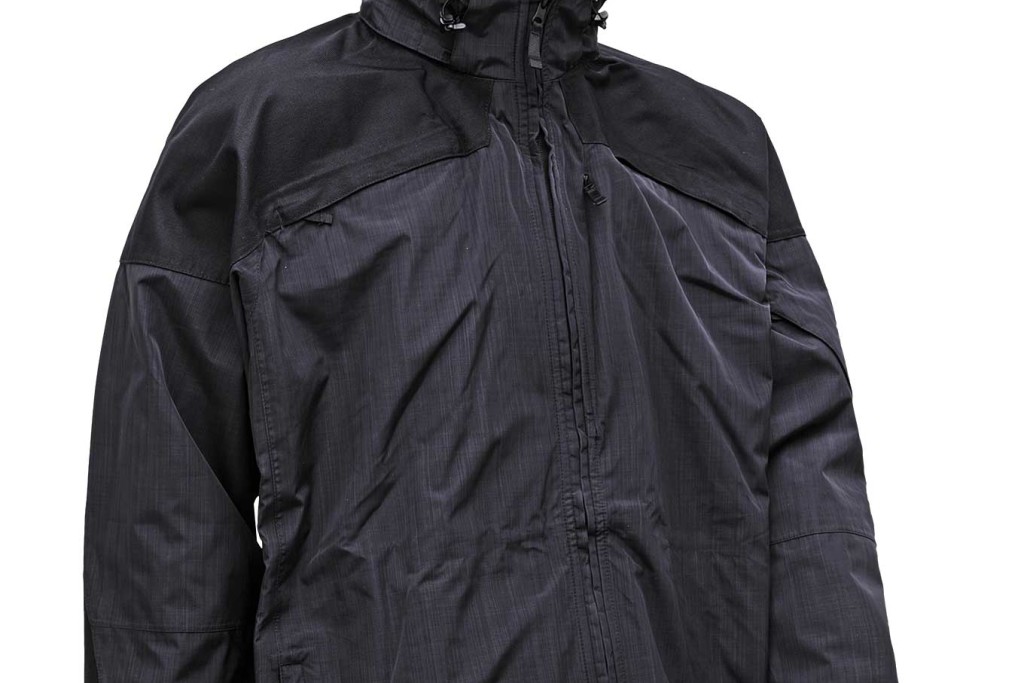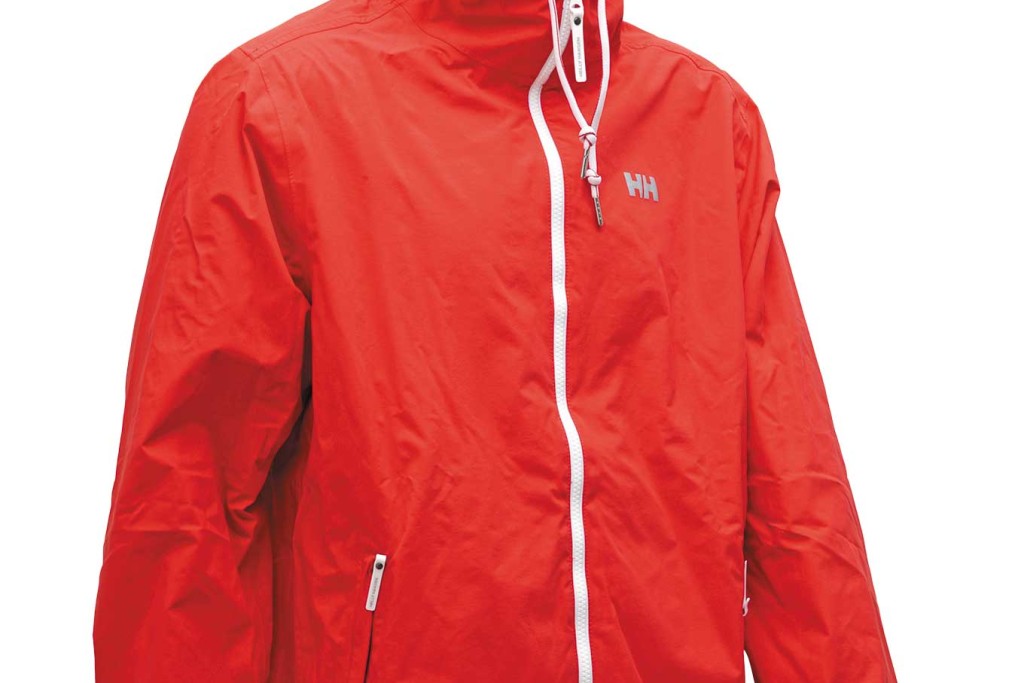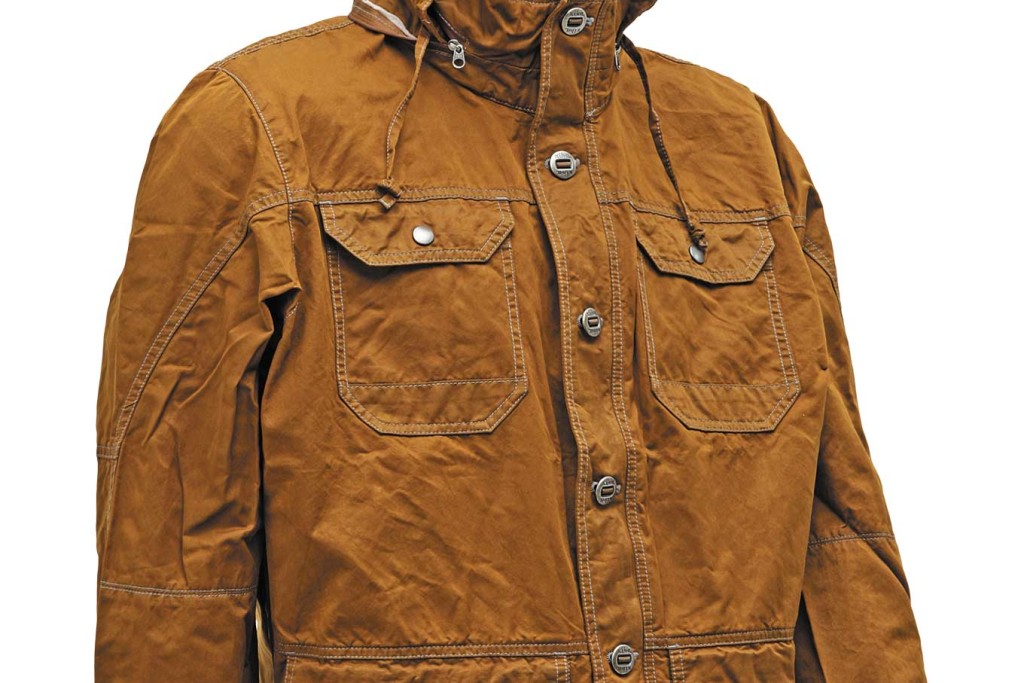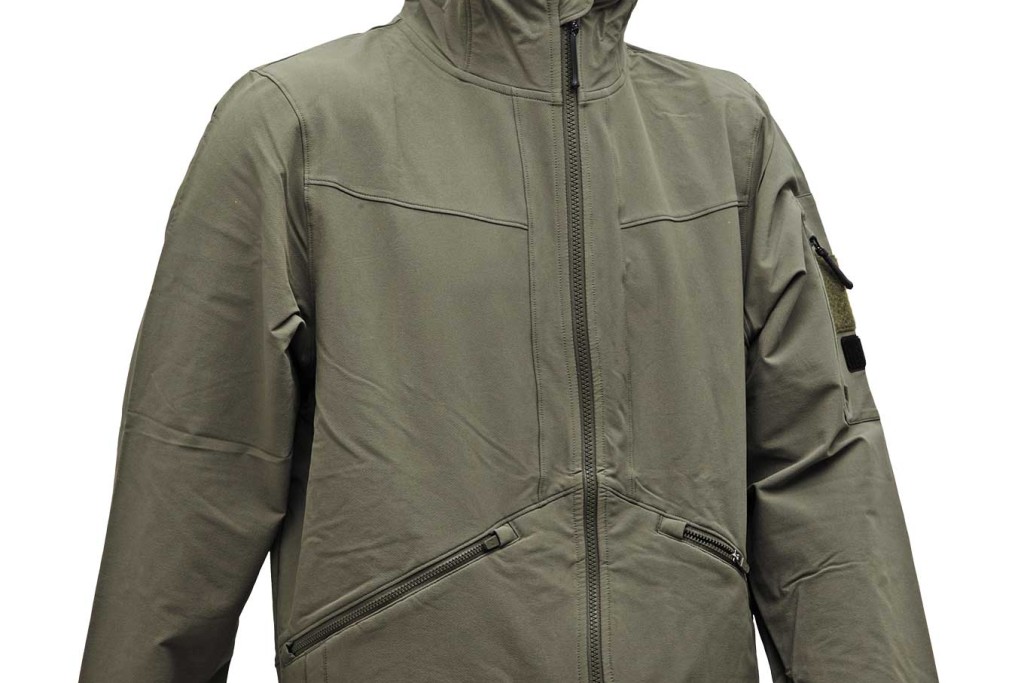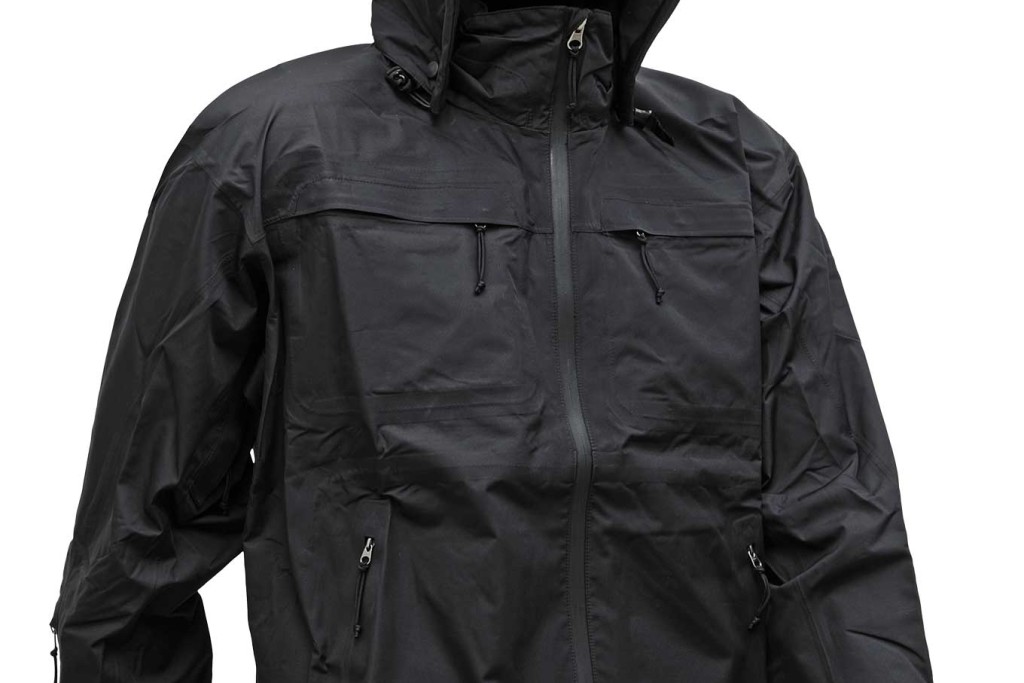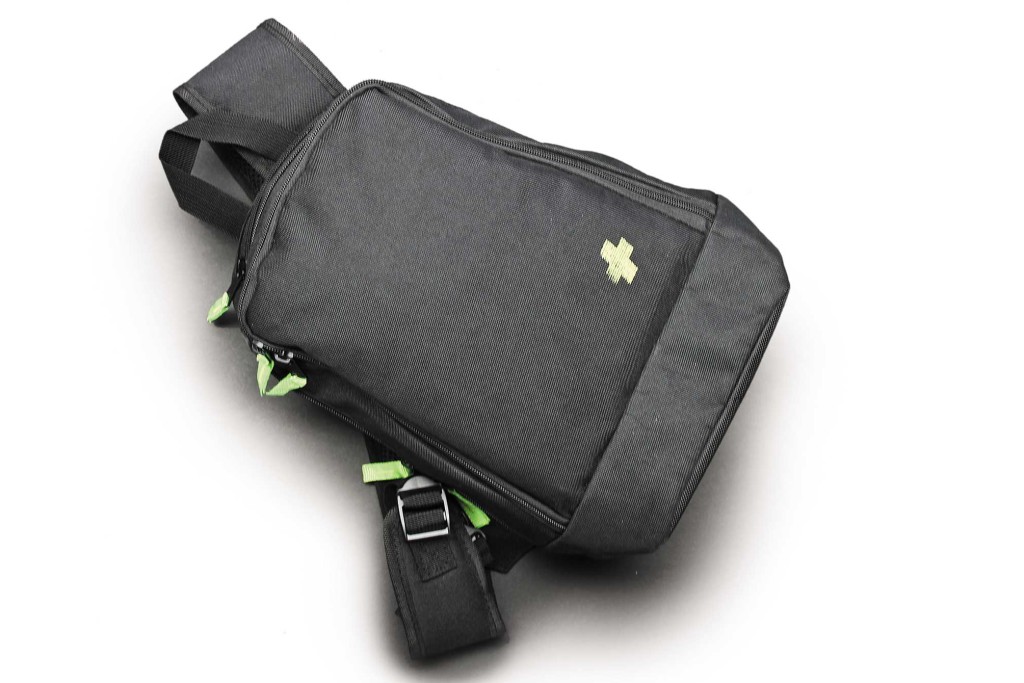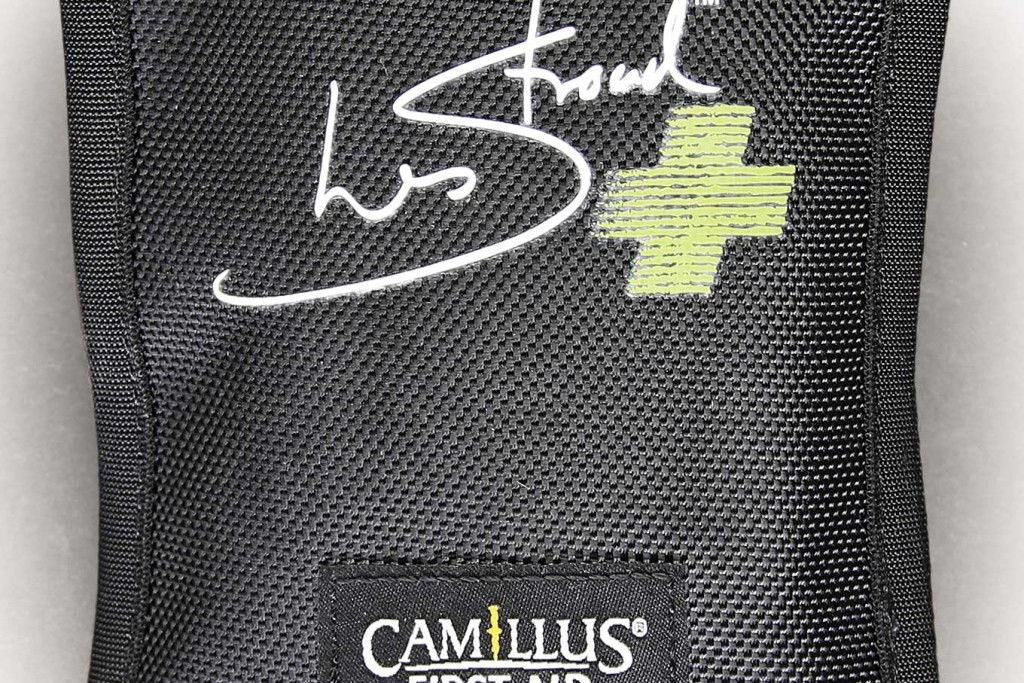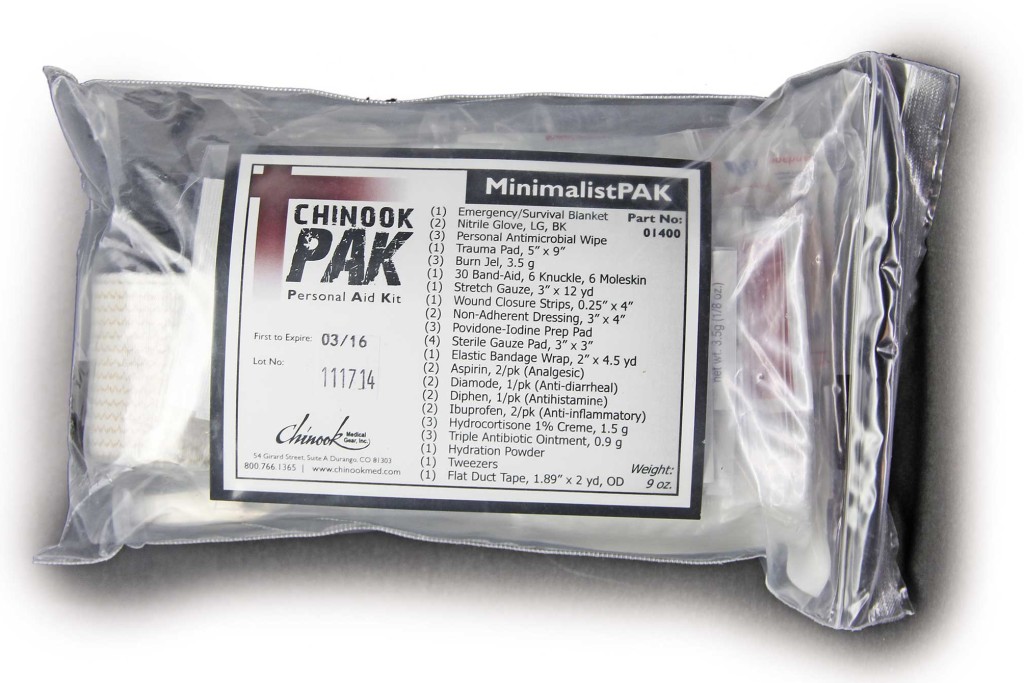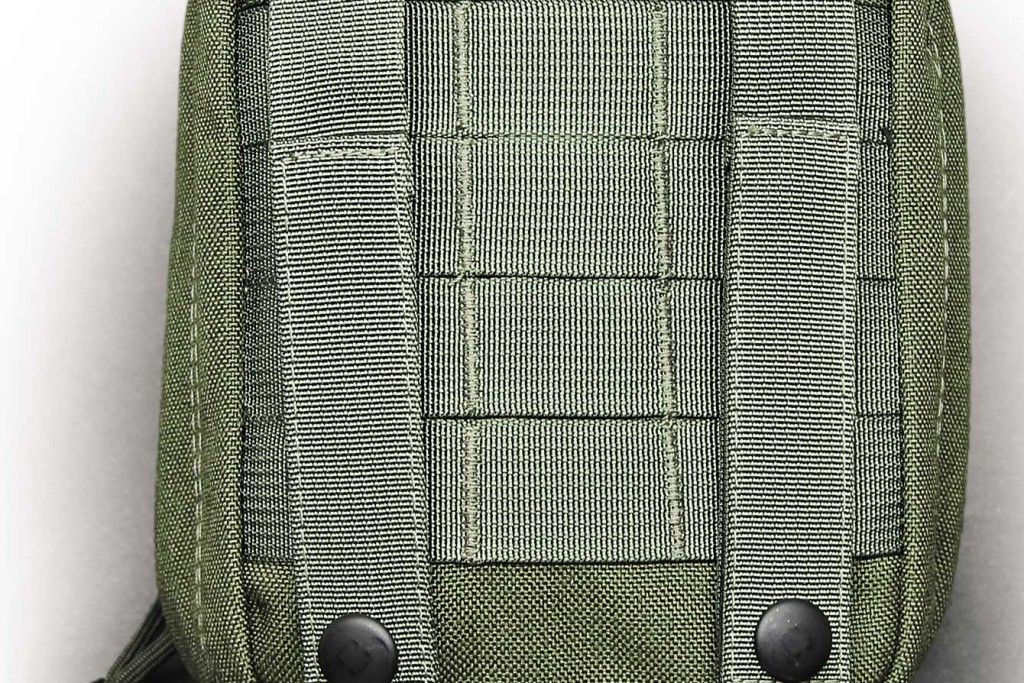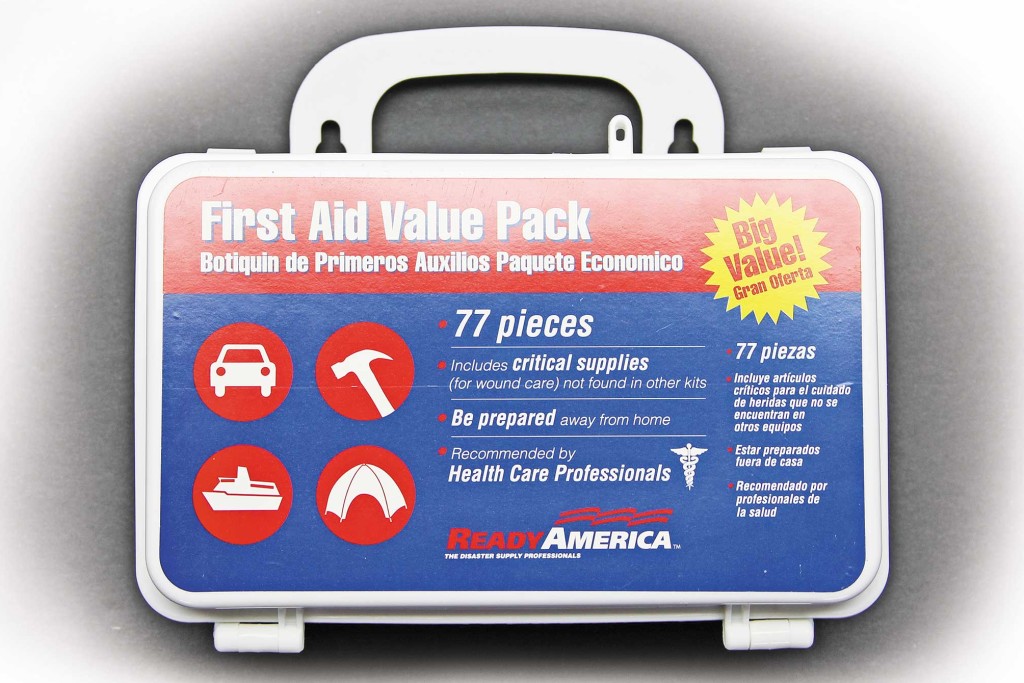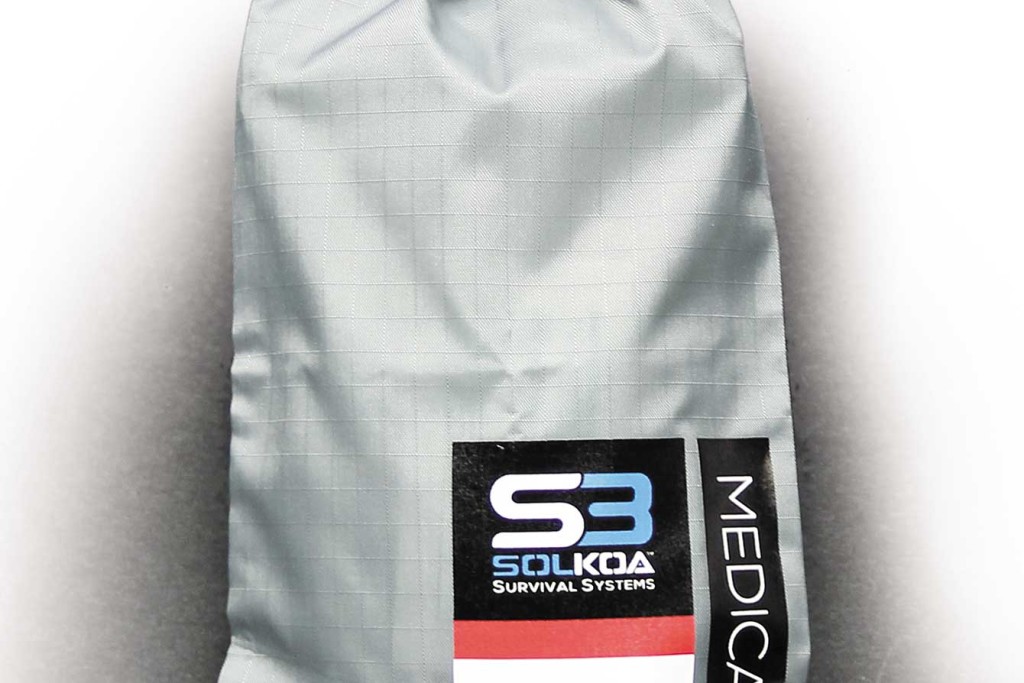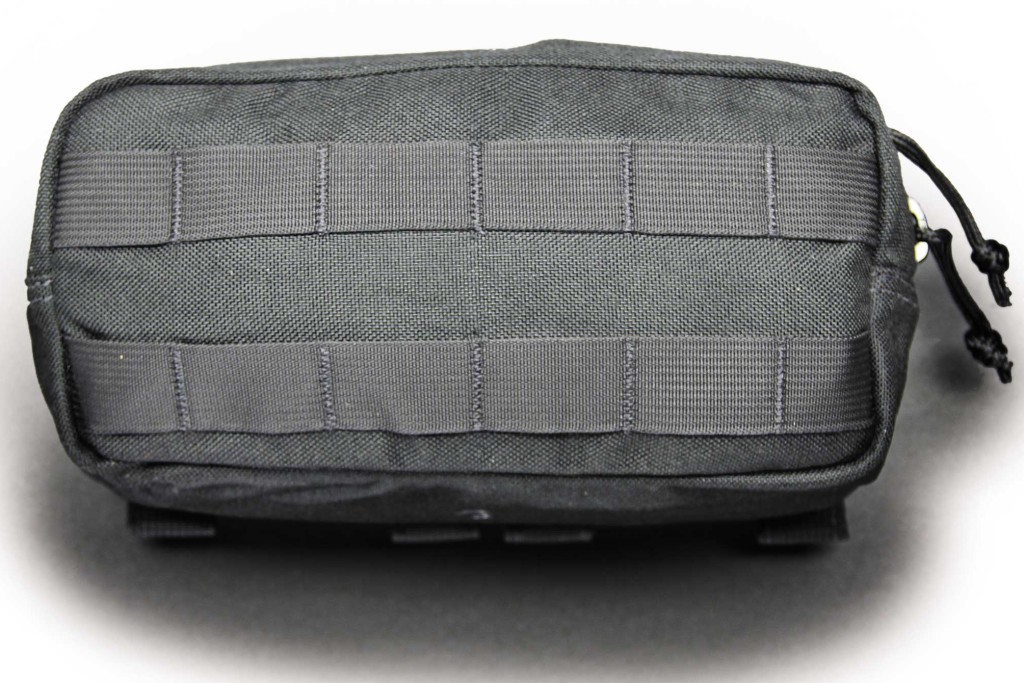It's been a couple of days and help still hasn't arrived. Being stranded, lost, and injured in the middle of nowhere wasn't how you pictured spending your vacation, but here you are. Having the innate sense to be prepared for just about every contingency has always been one of your strengths, and now you're about to benefit from it. With potable water levels dangerously low, food supplies all but exhausted, and your blown-out knee preventing you from hunting or gathering, you turn to your backup's backup plan: the almighty emergency ration bar.
You doubted that you'd ever need them. But because you're a survivor at heart, you weighed your options and figured that a few bars would add another layer of preparedness at the cost of just a few ounces and a negligible amount of pack space. Good thing you did. You can now sustain yourself longer while the search party works its way toward you.
If you've ever handled an emergency ration bar, you know that they feel as dense as bricks when they're sealed airtight in their long-term packaging. These rations contain much of what you need to keep your body and mind functioning and energized for high stress and high-energy survival situations because they're chock full of calories, carbohydrates, protein, fat, vitamins, and essential minerals.
Also, unlike MREs, which require water for their preparation, ration bars are designed to be consumed as is, no water or cooking required. They're also compact, as well as rated for storage up to five years and to withstand a very wide range of temperatures. As a result, these bars make sense to toss in a car's glovebox or even a bug-home bag in the trunk without worry that they'll spoil.
We took a quick poll around the OFFGRID office and realized that, even though most of us had these bars stashed away for a rainy day, a few of us haven't actually tried eating one yet. That in turn brought up the question, just how do these things really taste? Again risking our taste buds and digestive systems for you, our dear readers, we got nine different flavored ration bars from our friends at Emergency Essentials (www.beprepared.com) for a taste test. After our last taste test of canned meat (OFFGRID issue 6, “Meat Feast”), you may understand why “volunteers” had to be solicited for this assignment. We begged OFFGRID head honcho Patrick Vuong and our amazing bottomless pit of a managing editor, John Schwartze, to join in on our high-octane calorie fest. Because they're gluttons for punishment, they begrudgingly agreed. So read on and enjoy their “we're doing it for journalistic purposes” misery.
SOS Food Lab Inc. Apricot New Millennium Energy Bar

Notable Ingredients: Sugar, Palm Oil, Enriched Wheat Flour, Corn Starch, Wheat Gluten, Dextrose, Desiccated Coconut. (Not a Complete List)
Calories Per Bar: 400
MSRP: $1.50

Tester #1: Patrick Vuong
At First Bite: What do you get when you mix sand, sugar, cake, and a hint of fruit?
Overall: We need to resurrect J. Edgar Hoover, because someone needs to investigate where all the “natural” apricot flavor has gone. This product had the consistency of a 10-day-old coffee cake, the grittiness of a pile of brown sugar, and almost no flavor resembling the yellowy-orange fruit. Perhaps it's just my expectations, but I was sorely disappointed by this one. As a survival ration, I wouldn't say no. But it's definitely going to be sitting at the very back corner of the bottom shelf of my emergency food stores.
Tester #2: John Schwartze
At First Bite: Like eating an apricot-flavored piece of chalk.
Overall: This was very powdery tasting, almost like dehydrated Triaminic. The texture was hard to chew. Could I survive on it? Sure, but I'd probably deplete my water in storage pretty fast since it was so dry. It touts itself as an energy bar, but I think if fitness guru Susan Powter caught me eating one to feel livelier that she'd tell me to stop the insanity. One bar has 49 percent of your daily saturated fat intake, so I think it's best to describe this one as a fruity lead ingot.
Tester #3: Martin Anders
At First Bite: Like walking into a candle store with your mouth wide open.
Overall: If I didn't see the label and you were to ask me what flavor this ration bar was, I'd answer that it was a generic scented candle flavor. It tastes reminiscent of what the candle area at Bed Bath & Beyond smells like. You know that department — with its yoga music and rain sound effects soundtrack, it doesn't have a particular aroma or taste, it's just got a sweet, fruity kind of thing going on. That sums up what this ration bar is like, only that it's also dry and powdery in texture.
SOS Food Lab Inc. Blueberry New Millennium Energy Bar
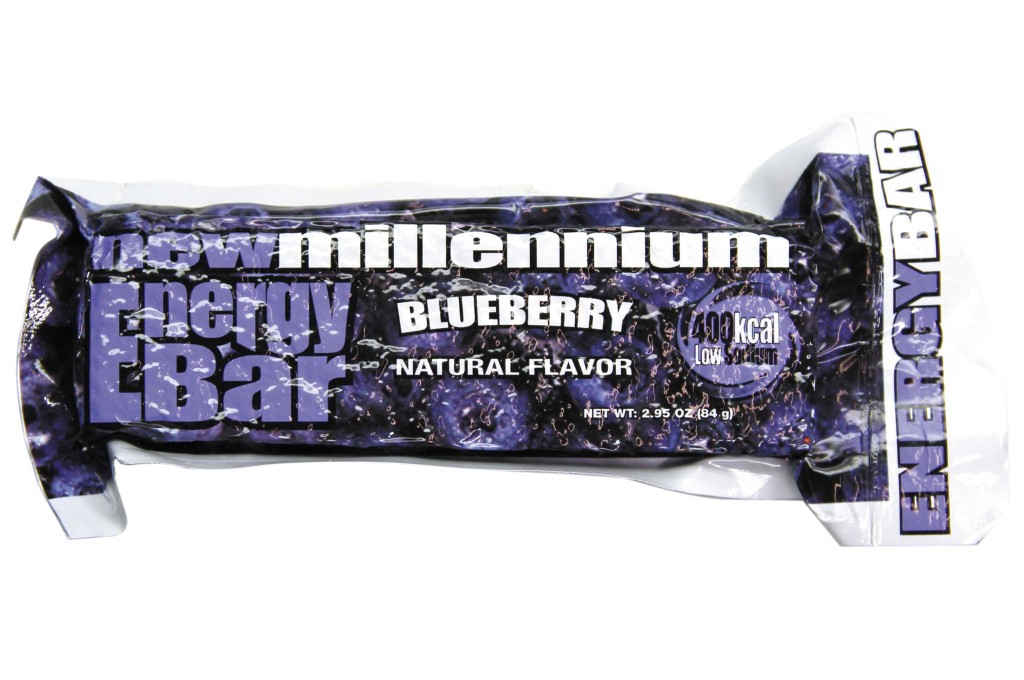
Notable Ingredients: Sugar, Palm Oil, Enriched Wheat Flour, Corn Starch, Wheat Gluten, Dextrose, Desiccated Coconut. (Not a Complete List)
Calories Per Bar: 400
MSRP: $1.50
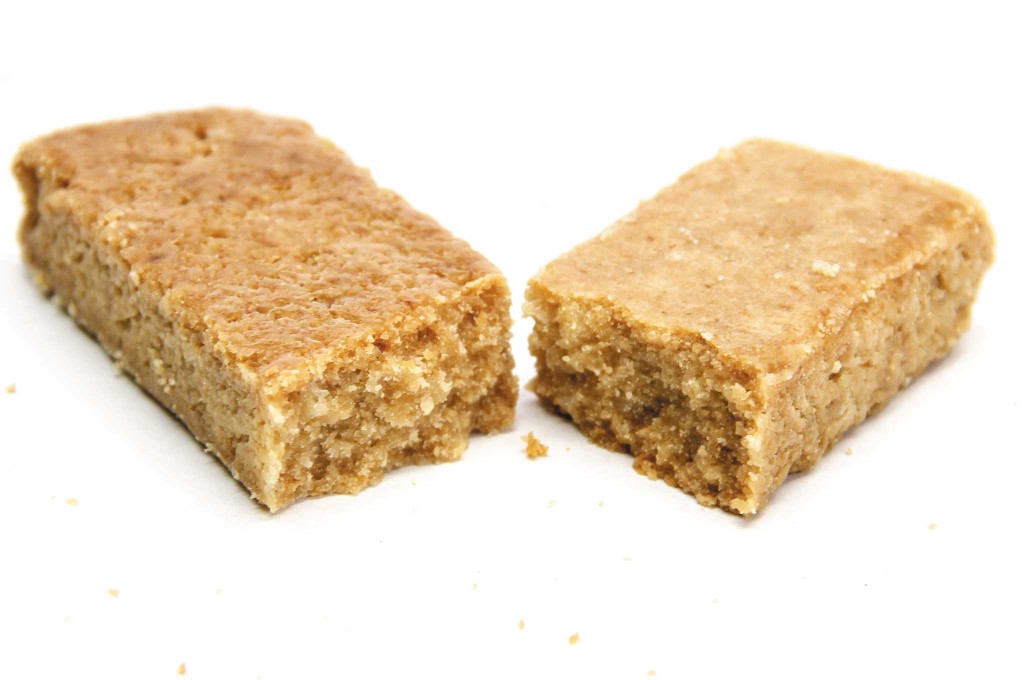
Tester #1: Patrick Vuong
At First Bite: Like a blueberry muffin that's been left out too long…but is too delicious to pass up.
Overall: Have you ever bought a dozen of the most perfect muffins from your favorite bakery only to curse the heavens a few days later when you realized you forgot to seal the leftovers in plastic wrap or place them in an airtight container? That's kinda how I felt biting into this bar. It was dry as sawdust and hard like a Jawbreaker, but, oddly enough, it was pretty good. After a few teeth-rattling bites, the bar crumbled into soft, enjoyable clumps.
Tester #2: John Schwartze
At First Bite: I may have cracked teeth, but at least it tasted good doing it.
Overall: I liked the taste quite a bit, but this was the hardest to chew of the bunch. Not sure if it's coincidence or something inherent to this particular flavor. Would've been quite good had it not been for the hard texture of the bar. I'd grade this one about a C. Points gained for making it appetizing, but points lost for something along the lines of peanut brittle in terms of consistency. Oh well, you can't have everything.
Tester #3: Martin Anders
At First Bite: Dry, but a blueberry-tasting treat.
Overall: This bar may look very similar to the others, but for some reason it seems a bit dryer. It takes a little more effort to bite through this one, but once you do, your taste buds will thank you. It's sweet and has a definite blueberry taste to it. The flavor reminds me of blueberry-flavored pancake syrup from IHOP.
SOS Food Lab Inc. Coconut New Millennium Energy Bar
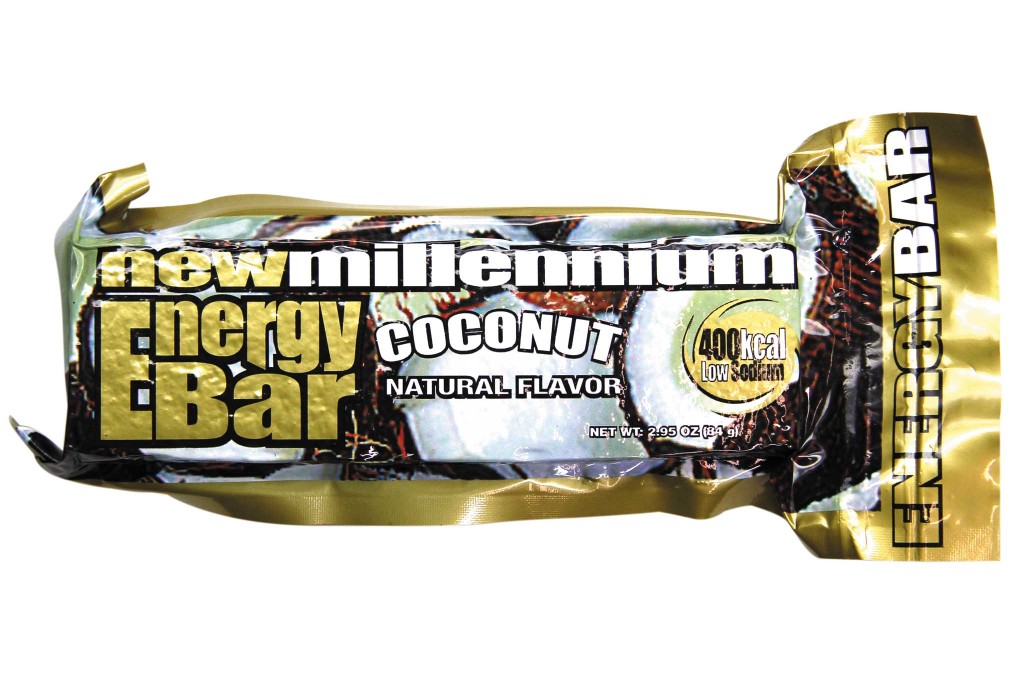
Notable Ingredients: Sugar, Palm Oil, Enriched Wheat Flour, Corn Starch, Wheat Gluten, Dextrose, Desiccated Coconut. (Not a Complete List)
Calories Per Bar: 400
MSRP: $1.50
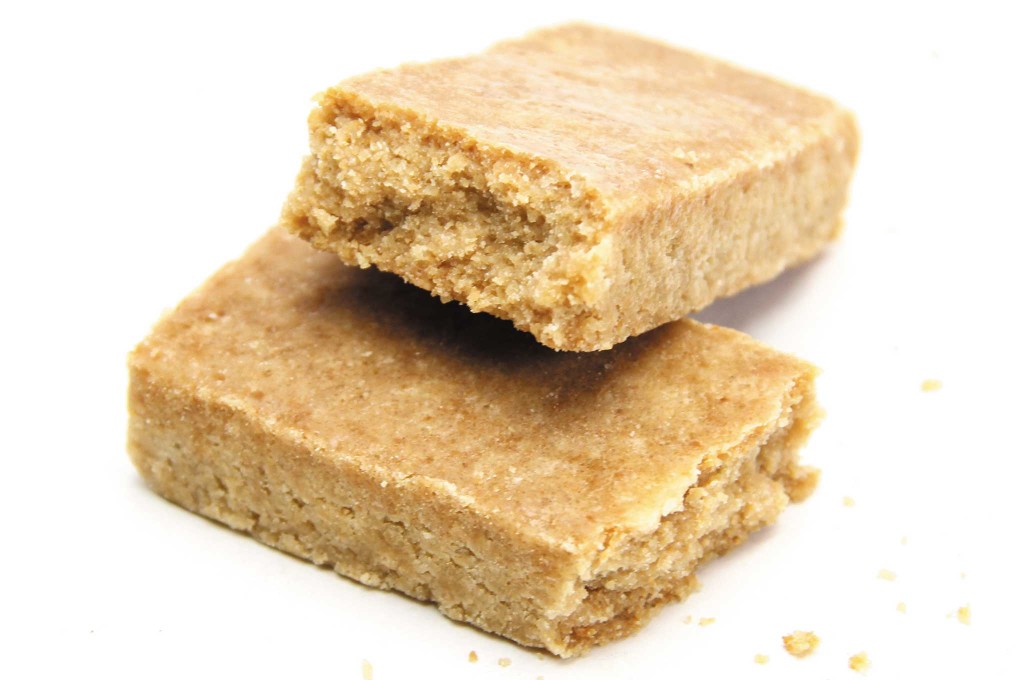
Tester #1: Patrick Vuong
At First Bite: Coconut? More like Koko B. Ware!
Overall: OK, lame pro-wrestling reference aside, you should be made aware that this ration bar tastes nothing like coconut. “Desiccated coconut” is listed among the ingredients, but little if any registered on my palate. Was it horrible? No, it's definitely more sweet than bland, if a bit gritty. But I just feel disappointed that I wasn't tasting coconut, especially considering I “volunteered” to munch on what looked like a hardened chunk of sand. Am I being too picky about something that is meant to be eaten only during the End Times? Probably. But even the world's last survivors need to get their tropical fruit on from time to time.
Tester #2: John Schwartze
At First Bite: This is coconut flavored? What'd they use, the husk?
Overall: This was on par with the apricot flavored one since it was made by the same company, but coconut isn't really a flavor I picked up when eating this one. Perhaps bland honey or vanilla, but that's it. Although the flavor is misleading, I did like it better than the apricot one. This wasn't too bad, but the texture was definitely not very light. Would resort to this one if I couldn't find one that was easier to chew. Call me crazy, but I'd imagine the chefs (or chemists more likely) who created these aren't Cordon Bleu graduates.
Tester #3: Martin Anders
At First Bite: I don't taste the coconut.
Overall: This bar is supposed to be coconut flavored, but I only taste sugar. The texture is probably as dry as the blueberry version, but flavor wise it's just sweet with little else added. Can I survive on it? Absolutely. Would I choose to buy this flavor again? That's a maybe.
Datrex 3600 Calorie Food Bar
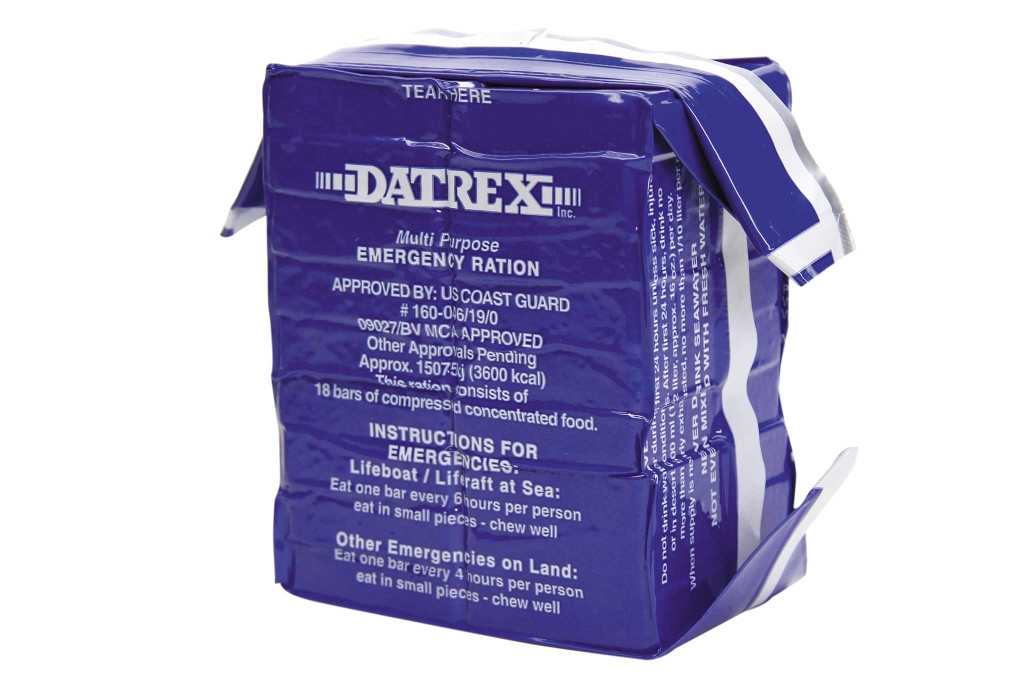
Notable Ingredients: Wheat Flour, Vegetable Shortening, Cane Sugar, Water, Coconut, and Salt.
Calories Per Bar: 200 (18 bars per pack)
MSRP: $8
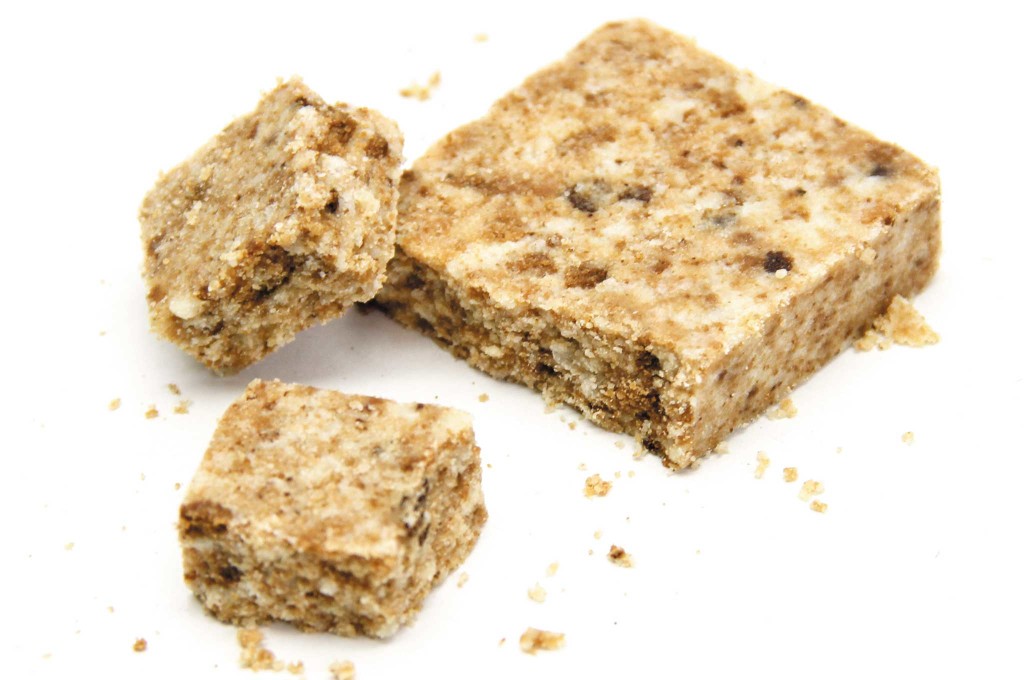
Tester #1: Patrick Vuong
At First Bite: Slightly sweet…then torturously clumpy.
Overall: This comes in one massive brick (which, in a pinch, could be used to smash bandits in the face). Once it's opened, there are 18 individually wrapped bars, each one slightly larger than a domino tile. They had an average cookie taste — until they crumbled and sucked up all the saliva in my mouth to create a chewy paste that reminded me of that time I failed the 60-second saltine cracker challenge. Still, if I were stranded, this would be a solid snack. Side benefit: This could be the healthiest option of this bunch, as its main ingredient is wheat flour and not sugar like the others.
Tester #2: John Schwartze
At First Bite: Middle of the road. Very light texture.
Overall: This one had the lightest texture of any I'd eaten. It was like eating wafer cookies. Taste was OK — mildly sweet, but a bit on the bland side. This would probably be your best choice for kids since the consistency was so soft. I wouldn't pass this one up since it was so easy to get through. If they could find a way to make the taste sweeter, they'd really have something here.
Tester #3: Martin Anders
At First Bite: Looking like a slab of SPAM, this is not at all what I expected.
Overall: Don't judge a high-calorie ration bar by its cover. Who could have guessed that a food called Datrex, which looks like a cross between a slice of SPAM and a slab of granite, could come close to my precious Pepperidge Farm cookies? Well, in my opinion this does come relatively close and tastes better than some things I've tried from Whole Foods. It has a nice very light sweet taste with a slight coconut aftertaste. As amazingly dry as it feels in your mouth, it somehow doesn't give you the need to wash it down with some liquid refreshment — unlike my favorite olde timey cookie
SOS Food Lab Inc. Lemon New Millennium Energy Bar
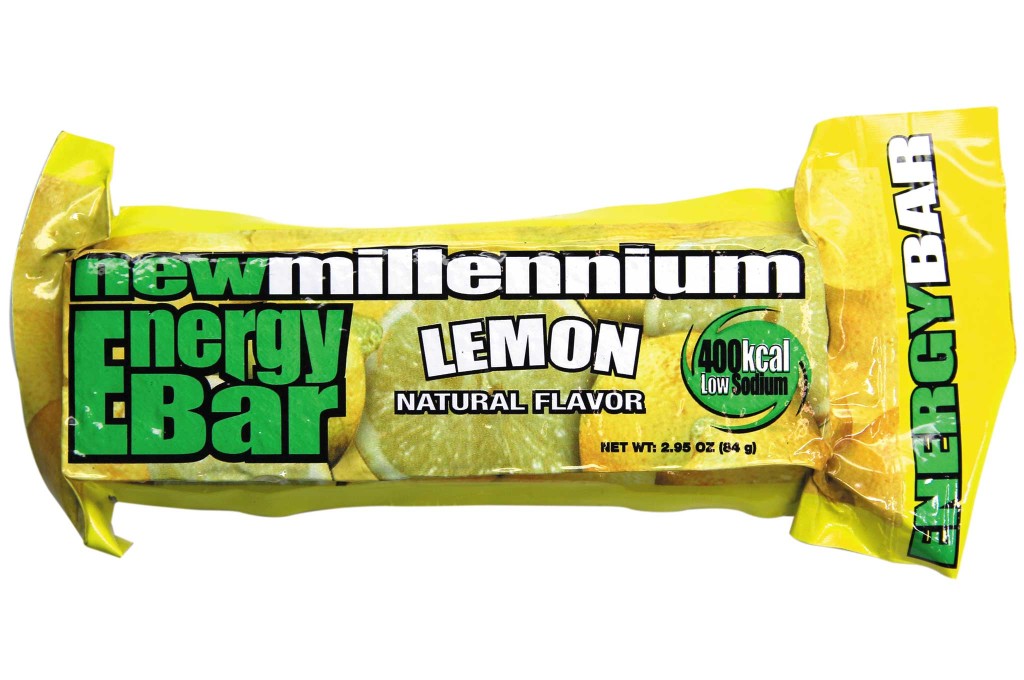
Notable Ingredients: Sugar, Palm Oil, Enriched Wheat Flour, Corn Starch, Wheat Gluten, Dextrose, Desiccated Coconut.(Not a Complete List).
Calories Per Bar: 400
MSRP: $1.50

Tester #1: Patrick Vuong
At First Bite: Like crunching on a rectangular-shaped Lemonhead candy.
Overall: Unlike most of the New Millennium bars, this lemon-flavored option actually tasted like the fruit that's pictured on its wrapper. It had a hint of citrus going in and a surprising tangy aftertaste. There's just one problem: I almost busted my four front teeth trying to bite into it for the first time. Smarting a bit after that first crunch, I shoved the bar back toward my molars, which were able to get the job done. It was good, if hard. Why can't this company make its rations have the same softness (or hardness, in this case)?
Tester #2: John Schwartze
At First Bite: Pretty good flavor, but hard as a rock.
Overall: I'm usually good with anything lemon, but those initial bites might use up my dental insurance deductible sooner than expected. Not as hard as Corn Nuts, but close. Hard until you start chewing it a few times. Flavor was sort of powdery and diluted with what tasted like Lemonhead candy mixed in. All in all not bad, but was on par with the blueberry for how hard it was.
Tester #3: Martin Anders
At First Bite: This lemon fan is still trying to figure it out.
Overall: I'm a huge fan of lemon-flavored bakery confections. Lemon meringue pie, lemon bars, lemon pound cake, the list goes on and on. Being the lemon fan that I am, I actually looked forward to trying out this ration bar. After a few bites, I was still undecided on whether I like this bar. On one hand, it does undoubtedly taste like lemon. On the other, I think it borders on being so artificially “lemony” that it reminds me of something like Lemon Pledge. While I'm still trying to figure this conundrum out, I've already put a few in my pack for who knows when.
Mainstay Products Inc. 3600 Emergency Food Rations
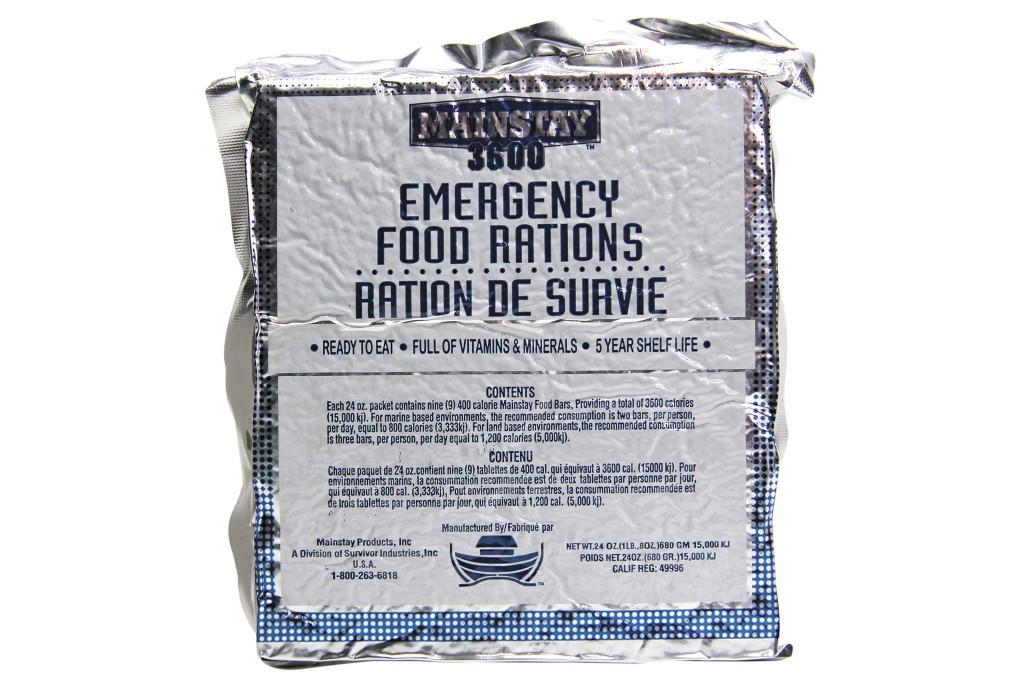
Notable Ingredients: Enriched Flour, Vegetable Shortening, Granulated Sugar, Corn Starch, Corn Syrup, Natural Lemon Flavor, Artificial Butter Flavor.
Calories Per Bar: 400 (9 bars per pack)
MSRP: $10
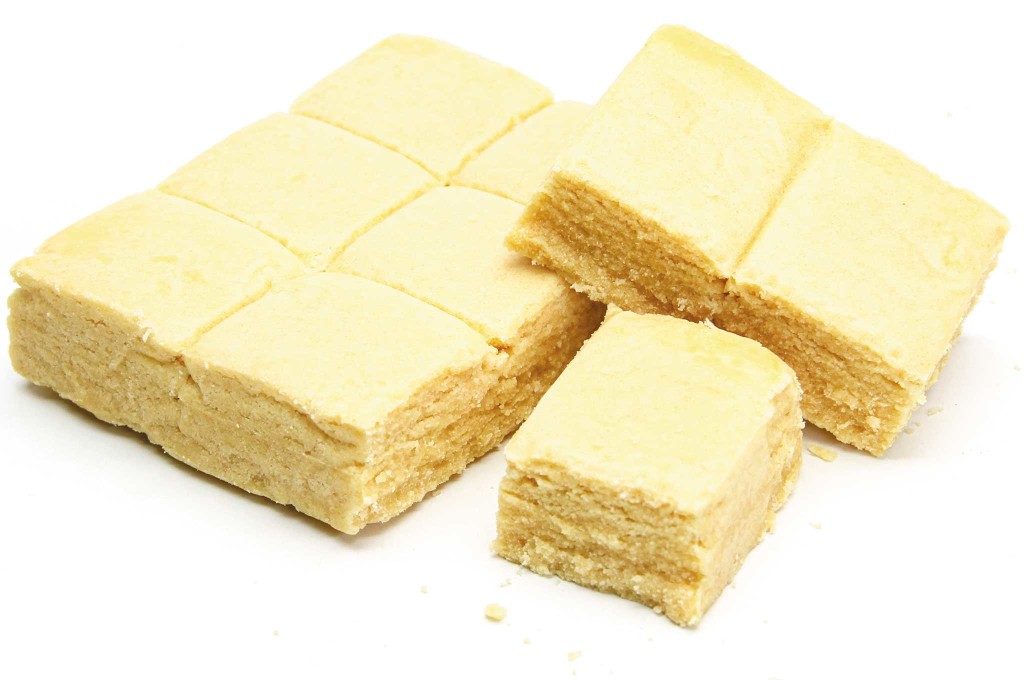
Tester #1: Patrick Vuong
At First Bite: Like eating peanut brittle, but without the sweetness, shine, or peanut.
Overall: This reminded me of tungsten: hard as hell until it shatters into a million pieces. Inside this package are nine super-dense slabs of concentrated flour, vitamins, vegetable shortening, sugar, and other “flavors.” The first cube was so hard I feared I'd lose a tooth or two if I bit into it, so I smashed it with the butt-end of a knife. Unfortunately, part of the slab crumbled rather than split up into manageable chunks. I basically had to shovel the mounds of tiny bits into my mouth as if I enjoyed eating sand. The good aspect is that each slab has plenty of nutrients to keep you going in a dire scenario and only 14 grams of sugar (less than half of the New Millennium bars). Plus, an unopened Mainstay package (about the size of square hardcover book) is ridiculously hard and great for throttling raiders.
Tester #2: John Schwartze
At First Bite: Looked tasteless, smelled tasteless, was tasteless.
Overall: This one was somewhere between dried Play-Doh and stale sugar cookies without much sugar. Hardly tasted like anything other than solidified flour. With so many other varieties that actually had some flavor, this would be my last pick. Nothing appealing about this one, and would make survival that much more difficult. I'd recommend this if you couldn't find anything else to live off of, and that's about it.
Tester #3: Martin Anders
At First Bite: It's lightly sweet and even buttery in a survival kind of way.
Overall: Imagine crumbling up a batch of half-baked, dried-out sugar cookies and forming them into a densely packed brick. That's pretty much what you get here. The flavor is not at all bad for a survival food option, but it does want to crumble all over — so be careful not to waste its precious bits when consuming it. Inside the airtight package is a large square chunk, scored into 9 individual pieces. The easy-to-break-off pieces are good for 400 calories of fuel each. One problem is that once that pack is open, there's no way to seal it up other than to try to fold the bag on itself. Each bar is not individually packaged, leaving it up to you to figure out how best to store the leftovers.
SOS Food Lab Inc. Raspberry New Millennium Energy Bar
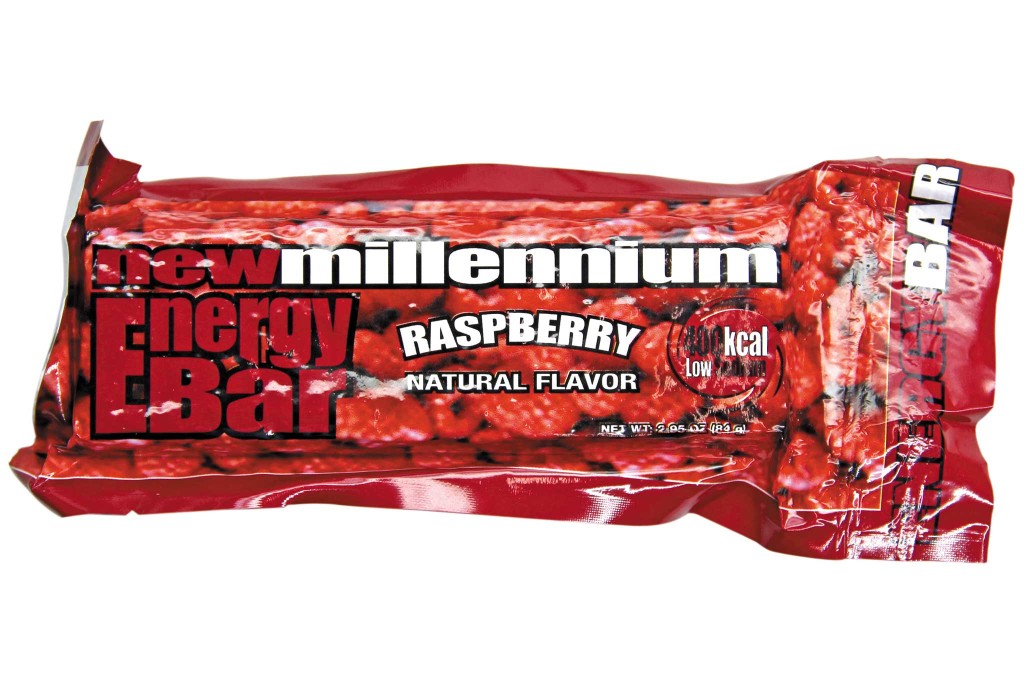
Notable Ingredients: Sugar, Palm Oil, Enriched Wheat Flour, Corn Starch, Wheat Gluten, Dextrose, Desiccated Coconut. (Not a Complete List).
Calories Per Bar: 400
MSRP: $1.50
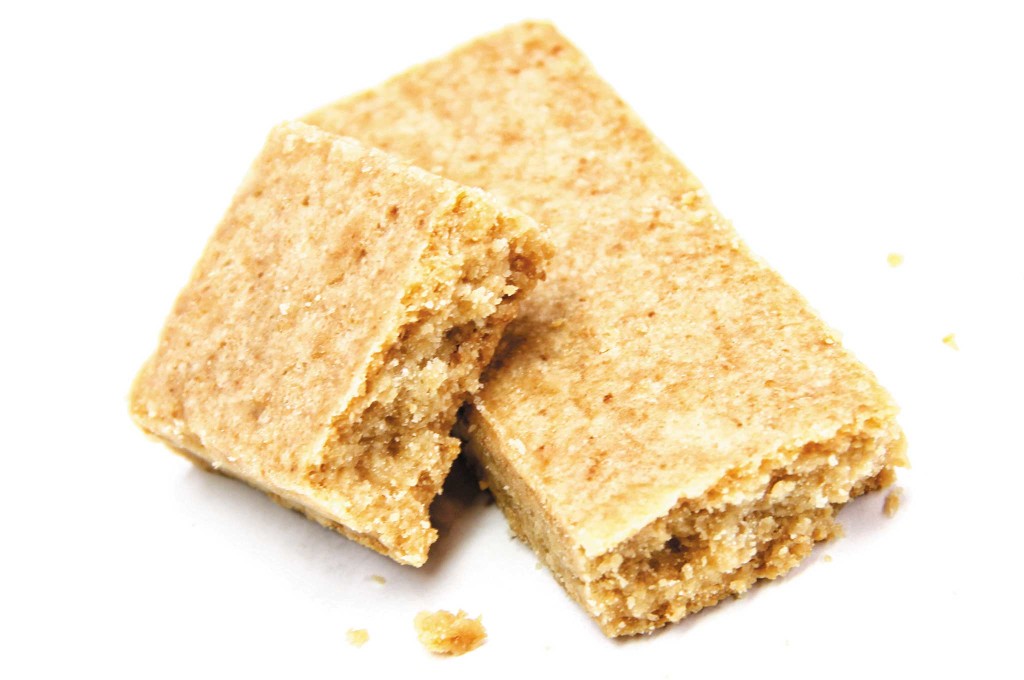
Tester #1: Patrick Vuong
At First Bite: A nice treat, and I didn't bust a tooth in the process.
Overall: This bar didn't require a hammer and chisel, so it definitely scores points for being softer than the others. In fact, I could break off a chunk using nothing but my fingers. As for the flavor, it was good — even if it barely tasted like raspberry. A closer look at the packaging reveals that it actually contains plenty o' sugar (as the primary ingredient, it clocks in at a whopping 32 grams per bar!), desiccated coconut (“desiccated” is a fancy word for dehydrated), and natural and artificial flavor (I guess that's where the “hint” of raspberry comes from).
Tester #2: John Schwartze
At First Bite: Raspberry! Only one brand would give me raspberry … New Millennium!
Overall: The best of the Millennium lot. I love raspberries, though, and you tend to eat with your eyes first, so my opinions may be biased, but it was flavorful. That's the one thing I have to say about the offerings of this company, they definitely give you variety and earn points for that. Texture wasn't bad. Not as hard as some of the others. I'd stock up on these for sure.
Tester #3: Martin Anders
At First Bite: Tastes like this morning's breakfast.
Overall: This bar fits in the cupboard next to my sugary breakfast cereal and breakfast bars. The raspberry flavor is distinct and, like the rest of the bars in this series, plenty sugary. The texture is easier to chew through than most of the other New Millennium Energy Bars, which further pushes Raspberry into the lead of this flavor competition.
SOS Food Lab Inc. SOS Emergency Food Ration
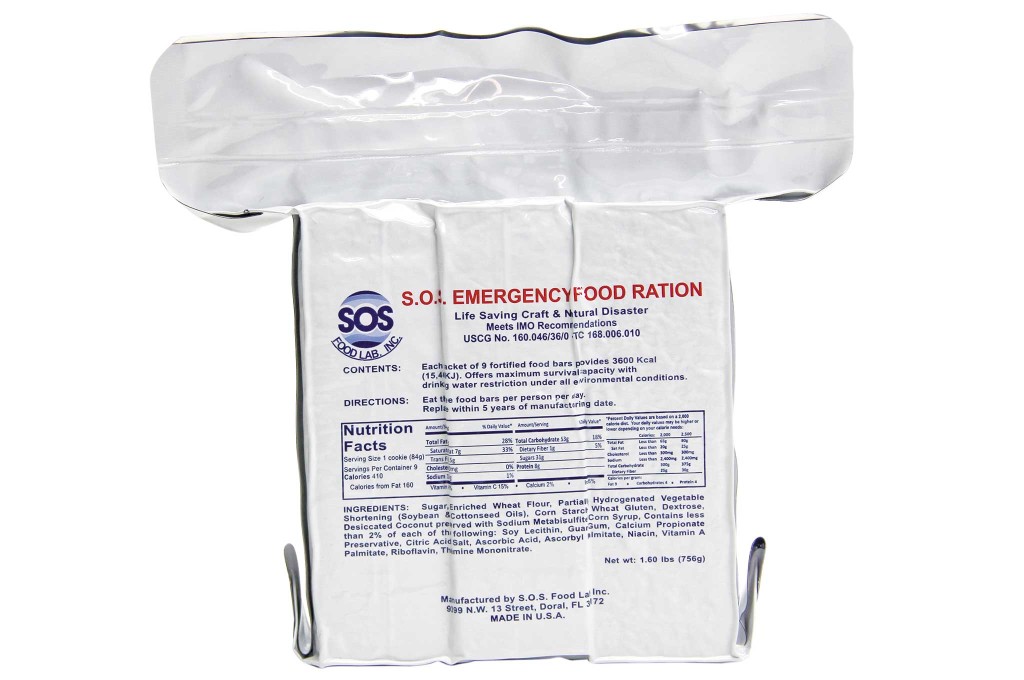
Notable Ingredients: Sugar, Enriched Wheat Flour, Partially Hydrogenated Vegetable Oil, Corn Starch, Wheat Gluten, Dextrose. (Not a Complete List).
Calories Per Bar: 410 (9 bars per pack)
MSRP: $8
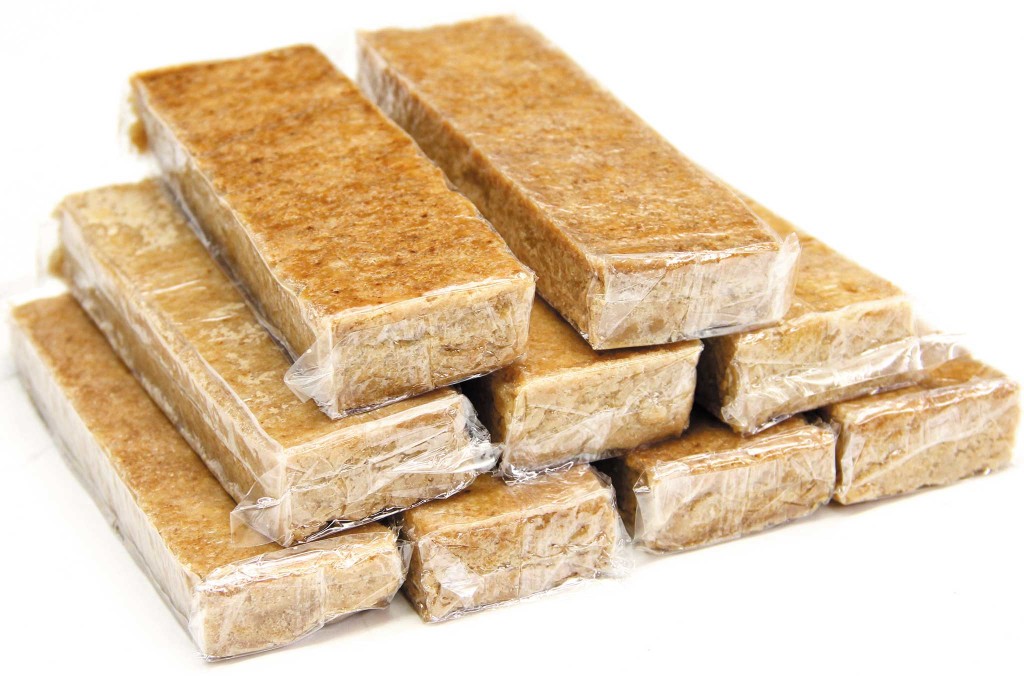
Tester #1: Patrick Vuong
At First Bite: Like grandma's cookies, but in the shape of a granola bar.
Overall: The SOS bar tasted surprisingly familiar, like a Christmas cookie made from store-bought dough. Then I looked at the nutritional contents and saw sugar listed as the No. 1 ingredient (31 grams per bar). No wonder my sweet tooth liked it. However, for some reason, the bar and the wrapping inside the packaging was greasy. Not sure if it's due to the partially hydrogenated vegetable shortening (listed as the third ingredient), but I suppose if I were starving in a life raft, the grease would be a moot point. If nothing else, an unopened brick of this brand would make for one wicked improvised blunt weapon.
Tester #2: John Schwartze
At First Bite: First bite tasted like vanilla wafers. Good.
Overall: So this one was the first ration I ever had. Had very low expectations of something hard, salty, tasteless, and completely unpalatable, but was pleasantly surprised. I think if I were to do a blind taste test with some high-end cookies on the market, I might actually choose this one. Sweet, not too dry, and crunchy, but not unchewable. Finished the bar with no problems and actually wanted another. Comes in a block of nine bars about the size of your average granola bar. You could easily survive on these for a while. No complaints at all.
Tester #3: Martin Anders
At First Bite: An enjoyable ration bar option.
Overall: Although it looks and smells very similar to many of the other ration bars, the SOS bars are a bit more cookie-like. The texture is not as hard or dry as the others in this taste test, and the flavor is a bit sugar cookie-like. Each of the nine bars is individually wrapped so stowing them each separately after you open the package shouldn't be a problem.
SOS Food Lab Inc. Vanilla New Millennium Energy Bar

Notable Ingredients: Sugar, Palm Oil, Enriched Wheat Flour, Corn Starch, Wheat Gluten, Dextrose, Desiccated Coconut. (Not a Complete List).
Calories Per Bar: 400
MSRP: $1.50

Tester #1: Patrick Vuong
At First Bite: Yummy, but didn't I eat this one already?
Overall: The taste of vanilla just brings a small smile to my face — and this bar did, too. Relatively soft without being too crumbly, it tasted as good as any pastry or candy bar I might actually buy at the check-out stand. This is the winner of this taste test, in my humble opinion. But oddly enough, this vanilla bar tasted similarly to some of the other new Millennium options, but just better. Hmm, perhaps that's why Disneyland pumps out vanilla scent through vents on Main Street (true story, bro) — because we perceive that smell and taste as familiar and pleasant, yet hard to pinpoint.
Tester #2: John Schwartze
At First Bite: My second favorite of the ones by this particular company
Overall: Texture wasn't too hard and flavor was actually pretty good. I think if I had to stock up on these types of bars, I'd easily go to this one. Was happy to finish the whole thing. Curious why there's such texture differences between flavors though, and if that really has an effect on how hard some are to chew. Thankfully that wasn't the case with this one. Survival actually tasted pleasant this time around.
Tester #3: Martin Anders
At First Bite: It's forgettable, in a vanilla kind of way. (Which is a good thing.)
Overall: If you're going to be eating something day in and day out, you can either go for different big bold flavors in an attempt to not get sick of it, or you can go for a non-descript, forgettable flavor that you might never get sick of. This vanilla is the latter of the two choices. This bar is as basic as you can get.
Best-Before Date
The great thing about ration bars is that they're designed to last a long time under a wide range of temperatures. Many bars can be stored at temperatures ranging from negative 40 degrees up to 300 degrees Fahrenheit without worrying that they'll go bad before you ever need them. (For specific details, take a look at the manufacturers' information.)
All of the emergency ration bars we featured in this taste test list a five-year expiration date. Many of the expiration dates are mandated through certifications, so they might actually last past those printed dates, as well. We do, however, recommend swapping out expired ration bars for new ones. After all, when it comes to food and water, it's always better to be safe than sorry!
Source
Emergency Essentials
www.BePrepared.com


